Japan English Guide
The Best Essential Guide of Tokyo Japan
Welcome to the best essential guide of Japan (of course, the title is ironic, all guides more or less offer the same), my name is… irrelevant. Let’s just say I am someone who has been living for a long time in Tokyo and, having to spend a couple of boring days in bed with an sprained ankle, decided to put together his advice about visiting the city.
Japan, Tokyo, Kyoto…of course, for a westerner, Japan is one the most desirable tourist destinations. All the oriental mysticism and exoticism minus the sometimes questionable hygiene and the constant fear of food poisoning or being robbed or swindled at every corner. Actually, Japan probably fares better than your country in all the things a tourist wants, which basically are excellent public transportation and locals don’t shouting at you (actually, the fact that English does not seem to be very useful just add more cuteness to the locals). Furthermore, we are talking about Japan, one of the pillars of modern popular culture, crazy Japan, that Japan that blends tradition and technological hyper modernity, so who does not want to visit at least once? (by the way, the average Japanese is as dull as your neighbor next door, crazy Japan is just the result of picking out of context the small percentage of freakish things that every society has, and amplify them trough the internet and TV). Of course, living here is a very different matter, but that is not the object of this page.
The information given here is more or less accurate by the time I am writing this, which is the fall of 2018 (update: i read again the page again in January 2025 and made a few small changes, so the definitive version is for January 2025). By the time you are reading it, it could be the case that Martians have already obliterated the whole Japan, so take into account that things could be a little different when you go to Tokyo.
---------------------------------------------------
First, let's consider the general plan for visiting Japan.
Starting from the almost inevitable principle that if you travel to Japan you must visit Tokyo, the 3 basic options that are usually considered for a first trip to Japan are as follows:
Option A) See only the Kanto area (Tokyo and surroundings).
Option B) See the Kanto area and the Kansai area (Kyoto, Nara and Osaka).
Option C) See the Kanto area and other areas of the country (including the Kansai area or not).
Of the 3 basic options given above, there are two tips I can give:
Tip 1 (written in 2025):
As of today, the Kansai area has unfortunately degraded touristically, so is better to avoid the option B above. Especially Kyoto is a relatively small city and the huge influx of foreign tourists has the effect that visiting it can be a bit disappointing (lately this is an opinion I have heard from all groups of friends who have visited Japan, besides becoming a common opinion among foreing residents).
Tip 2:
For a trip of no more than two weeks, the Kanto area (Tokyo and surroundings) is enough to have a tourist experience of the same quality as making the effort to travel to several remote areas of the country. Moreover, in this case you will not only save the stress of moving hundreds of kilometers carrying a suitcase, but you will also save a great deal of money.
In fact, this tourist guide is focused on Tokyo, in this page we propose you how to visit Tokyo and surroundings and we will give you plans to occupy a trip of up to two weeks.
If your travel plan is longer than two weeks, you can spend the first two weeks in the Kanto area as explained on this page and leave the extra time to travel to other areas of the country. If you wish to plan days in areas beyond Kanto, for example, you can consult https://www.japan-guide.com/.
Also, if you are planning a long trip of several weeks you will have heard about the Japan Rail Pass. Nowadays, the Japan Rail Pass has become so expensive that in most cases it is not worth buying it (especially for a trip of no more than two weeks without leaving the Kanto area as I recommend, buying this pass becomes a waste of money).
-----------------------------------
Now, let’s consider a few things before the travel
– Weather (what clothes do I put in the suitcase?):
OK, I’m not going to make any explanation about that, just check the Wikipedia entry (https://en.wikipedia.org/wiki/Tokyo). The only thing I am going to say is that summer is Asian humid hot (although not crazy humid hot as Thailand or Vietnam), so if you travel in summer, prepare to sweat a lot. In fact, I will add as a comment from 2025 that given the rising temperatures, from mid-July to early September tourism is simply not advisable, spending long periods of time outdoors at that time is an invitation to have a heat stroke.
– Money
As stealing and robbing is less usual than other countries, and because of other reasons, Japan is still a very cash oriented country (to the desperation of the Japanese Government). The situation has been improving, but still some restaurants and shops are cash only, and credit cards from outside Japan sometimes are not accepted by the machines here.
I remember a German guy who came just with his credit cards (probably linked to his Deustche Bank account) and zero money. Lets just say that he found the hard way that it can be problematic in Japan if you do not have cash.
In Japan you can carry a lot of cash in your bag and still be safe (as long as you don’t forget it in the bathroom of a restaurant or left it unattended in some place). My advice is to check the exchange rate for your euros or dollars at the money exchange offices in the Japanese airport where you plan to arrive (probably Narita airport:https://www.narita-airport.jp/en/service/svc_11) and, unless you can find a better deal at your home, change to yens there (by the way, leaving aside the airplane ticket, this travel budget is not expensive at all, lets put 60 dollars/euros per hotel night (so 30 if you share room with a travel partner) and add to that a daily average cost of 30 dollars/euros for trains and museums and 20 for food, that means 80 dollars/ euros per person per day).
– Crime
Japan is a country where the majority of criminals are concentrated in other type of crimes rather than pickpocketing or robbing at gun point, which means that for a tourist like you is pretty safe as long as you follow the same precautions you use at home. However, that does not mean that if you do something stupid you will get a free pass. For example, in this guide you pass trough the red district of Tokyo, called Kabukicho. Basically, you can walk at midnight in Kabuchiko waiving a stack of 10000 yen bills and you still would be probably safe(only in the sense of not being robbed), but if you think that is a good idea to take a picture of some tattooed guy in Kabukicho, you will probably find your camera smashed to pieces. And if you think you want to start a fight about that, the cops will arrest you as all the witness in the area will assure that you are the bad guy (regardless of what you consider to be the truth). The bottom line is, remember not to do anything stupid and you will be fine.
– Accidents and Illness
In principle, hospitals in Japan are private, that is, 100% operated for profit. That means that if you ever have to go to one, after getting treatment, you will be taken to the payments counter and expected to pay for absolutely all. Most of the people living in Japan show at the payments counter their national insurance card, which will waive you 70% of the money, but since you do not have one of this cards, expect to pay 100%. Of course, if you have a travel insurance, you can ask a repayment to the insurance company when you are back to your country. However, as far as I know, your average Japanese hospital only makes its bills in Japanese, so you are going to have a lot of fun when dealing with your insurance company. Anyway, it would be a good idea to bring in your wallet the directions of a couple of English speaking hospitals in Tokyo (just look in Google).
– Electricity
Like weather, this is something I will not comment in detail. Just do not forget to check on Google what kind of plug adapter you need to bring from your home if you intend to use your own electrical devices (https://www.japan-guide.com/e/e2225.html).
– Internet and Smart phones
For the reasons I will explain later on, you will need a smart phone with 24hours capacity of connection with the internet when following my guide. Also, buy or lend a couple of portable batteries for the phone with their respective cables (with the phone connected to google maps all day, soon the phone battery will dry out) and also a multiple outlet extension cord with 3 entries (the hotel will not have many outlets, so every night use the extension cable to let charging all night the phone and the two batteries at the room).
If you use your smart phone with your local carrier in Japan, be careful with not finding a huge bill of thousands of euros/dollars when going back home. You can compare your local carrier prizes for using your smart phone abroad with the prize of renting a SIM card or a smart phone at the Japanese airport from where you arrive to Japan and decide what is better for you (https://www.narita-airport.jp/en/service/svc_19).
– Hotels
My advice for finding a hotel in Tokyo is as simple as opening Agoda.com or whatever site you normally use to search for hotels, select all of Tokyo area (with only hotels), and search starting from the lowest prices (making sure you choose a private room with a private bathroom).
Regarding the position of the hotel, forget about whether it is in X or Y neighborhood, the trick is to look with google maps how long it takes to get from the hotel to any of the Yamanote line stations (you can check the list of stations here: https://en.wikipedia.org/wiki/Yamanote_Line ) and if you find at least one station to which it does not take more than 45 minutes to arrive, the position of the hotel is acceptable.
With the above search pattern, you should be able to find a room for two people in the price range of 50~70 euros per night per room. Be aware beforehand that the room will be very small (compared to what is usual in the West) but do not worry about hygiene (hotels in Japan are usually very clean). You will also sometimes find that you are offered what used to be “love hotels” (hotels by the hour for couples) or even hotels that are still mainly for couples (“adult only” hotels), in this case the hygiene standards are as good as ordinary hotels, the security just as good, and the room sizes usually larger (and wooden partitions at the windows) so is not an option you should avoid.
I cannot say anything about hostels as I never tried and capsule hotels are not an option for you. Airbnb type private renting was a popular option until the government created a law where in theory is possible to rent an apartment but in practice is very difficult, but you can check and see if there is anything that seems to suit you.
– Trains
With a massive city of tenth of millions of people moving every day, the urban train and metro transportation is not huge but also the only practical way to cover relatively long distances when moving in the city.
There are dozens of train and metro lines operated by different companies, but the good news for you is that the itineraries given in my guide mainly use the biggest stations of the JR (Japan Railways) company which are quite easy to access.
At the entrance of any station, you can find the ticket machines where you buy a ticket for any amount of money that you want. The more expensive ticket you buy, the more far away are the stations you are allowed to get out from the station you bought the ticket. For example, if you are in JR Tokyo station and want to leave from Shibuya Station, you need to buy a 210 yen ticket (the price for each station counting from the station you are is written in a big map above the automatic vending machines). Once you have your ticket, go through the ticket check point and insert it in the control machine (of course do not forget to take it while you are entering the station). Which combination you use to go from Tokyo to Shibuya is up to you (but is not difficult to decide it if you carry a map of the stations). When you arrive to Shibuya, just put the ticket in the control machine and leave the station (the machine will keep the ticket).
Of course just with this confusing explanation you are thinking right now that is going to be difficult to use the train in Tokyo. But once you try there you will see that is pretty easy. Just remember the basics given in this explanation.
By the way, here is a map of JR Tokyo train stations (just keep the PDF file in your smart phone and save data use:
http://ontheworldmap.com/japan/city/tokyo/tokyo-jr-map.jpg) . Google maps do the best job calculating train routes in Tokyo.
– Food
Well, Japanese food is famous enough to need many explanations. You have to try the basics of every day Japanese eating which is ramen, udon and soba for pasta dishes plus guydon (rice with meat slices), tonkatsu (pork coated in breadcrumbs & deep-friend) , rice with curry sauce, Yakiniku (roast chicken) and tempura (fried vegetables) . And of course sushi. Whenever you want to have lunch or dinner search in Google maps for some Matsuya or Yoshinoya or Sukiya or Hidakaya or Gyoza no Ousama (chains that serve most of the dishes above). Notice that in some of this kind of places you first buy a food ticket in an automatic vendor machine and you give the ticket to the waiter. By the way, you already know, but remember that in Japan there are not tips.
--------------------------------------------------
Time to start with the travel.
As I mentioned someplace above, for this travel guide what I do in some cases is to put links to Google maps with itineraries and some comments where could be needed for each route provided on this page.
Now, if you are special forces level good at using maps, I guess you do not need to use your position localizator on Google maps (the blue dot). But otherwise, I implore/order/scream at you to make sure that you can check anytime your position in the linked Google map while you are following my itineraries and also use google street view anytime you get lost.
Also, when preparing the trip, check on the web pages of the museums and temples when are they expected to be closed so you avoid the surprise of arriving there and find that you cannot enter to the place.
For any itinerary, check in advance the given distances and calculate how much time you will need walking at your own pace. For museums give yourself at least one hour, and also give yourself and approximate time schedule including your time for lunch (look in google where you can have lunch) so you know at what time you want to be at each place. As parks and other places to sit are scarce in Tokyo, whenever you spot a MacDonald you can buy a 100 yen drink and sit for a comfortable pause. Also you can take an even more comfortable pause whenever you spot a Starbucks and the Japanese variants (Doutor, Caffe Veloce, etc), but in this case the cheapest drink is going to be 3 times more expensive than MacDonald.
If you need to go to the bathroom, you can look the closest one of the following searches on google maps: 1) just look for the word toilet and maybe you are lucky 2) Big parks usually have public toilets 3) look for convenience store (most of them have a toilet, proper manners request that after using the toilet you buy the cheapest item of the store (usually a small chocolat bar for 40 or 50 yen) as a thank you sing) 4) look for the closest train or metro station, buy the cheapest ticket (usually around 140 yen) and use the toilet after the ticket control area, when you are done just go back to the ticket control area and give the ticket to the employee, he will let you go out).
Also, for those of you that like to extend the tourism journey until late at night, be aware that in tokyo from a little later after midnight until around five in the morning there is no public transportation (and taxis are crazy expensive, better avoid them). If you lost the last train, still there you can find a macdonal, starbucks or similar that is open 24 hours and you can wait there until 5 in the morning).
----------------------------------------
The basic plan I explain below covers two days in the urban area of Tokyo (Urban Tokyo) and two days to see the best of the outskirts of Tokyo (Outskirts / Traditional Tokyo).
In the weird case that you can only have two tourist days for Tokyo in your Japan travel plan, then do the 2 days of the Urban Tokyo part, and if you only have 3 days for Tokyo area, do the Urban Tokyo part and one day of the Outskirst/Tradional Tokyo part. I leave to you to decide the concrete days order for the visits.
----------------------------------------
Urban Tokyo
Urban Tokyo consists of 2 itineraries, one itinerary per one day. You do not need to do first the itinerary one. Actually, you can mix the order of this itineraries with the Outskirts/Traditional Tokyo itineraries if you also plan to do them.
Itinerary One:
For this itinerary is better to start visiting the Tokyo National Museum at its opening time, which usually is 9:30.
Itinerary One, first walk: Tokyo National Museum -> Ueno Park (shinto shrine Goyoten) -> Ameyoko Market (Buddhist temple Marishiten)-> Traditional japanese house (mansion Iwasaki family)
The link to map is below (if your map is displayed wit car route of course change it to walking route, i put a pic below of what should be the route):
https://www.google.com/maps/dir/35.7175374,139.7755567/35.7135946,139.7723166/35.7119983,139.7740761/35.710868,139.7745241/%E6%91%A9%E5%88%A9%E6%94%AF%E5%A4%A9%E5%BE%B3%E5%A4%A7%E5%AF%BA/35.7094694,139.7683073/@35.7095756,139.767799,20z/data=!3m1!5s0x60188e9f96b44977:0xc2c08e22d80a22d!4m13!4m12!1m0!1m0!1m0!1m0!1m5!1m1!1s0x60188e9f946d5847:0xb6dffad13b23fb8d!2m2!1d139.7745549!2d35.7085662!1m0!3e2?entry=ttu
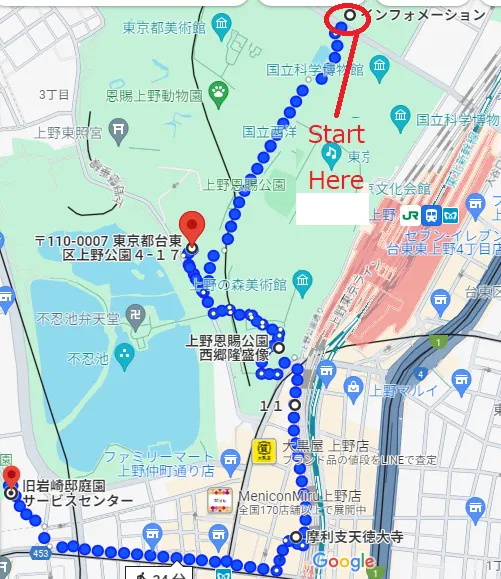
Use google maps to arrive to the entrance of the Tokyo National Museum. Pay your ticket at the fenced area and go passing the long fountain to the building below.
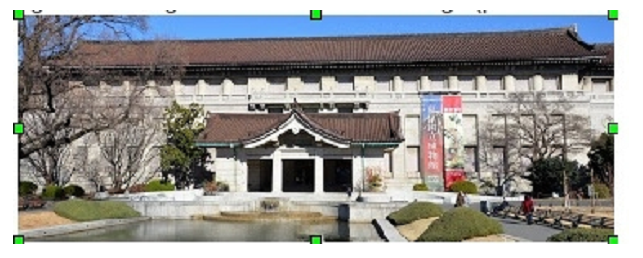
Climb the stairs to enter the museum and once inside , go upstairs (photo) to the upper floor and turn to the left to start the chronological expositions (where it says highlights of Japanese arts, photo). From here I am talking just from memory and I have not gone in years, but the first area has some artifacts of the first recorded cultures of japan, first the yomomji and later on the yayoi (from the last 2000 years japan has been pretty homogenize but genetically speaking japan is a big mix of the ancestors of present Koreans, Chinese, Mongols and South Asians who came in successive waves to the Japanese islands).
After that it comes the culture of the big tombs, but notice that this culture is from 3th century and Japan still lacks writing systems or other advanced cultural artifacts, however, with the tag of Nara, 7th century, you have in the same space a statue of Buddha superbly created and documents written with Chinese characters.
What happened was that, after millenniums of poorly advanced cultures, in the 5th century a clan near to actual Osaka called the Yamato where able to subjugate most of the other clans on the islands, and the Yamato decided to invite Chinese Buddhist monks and Korean nobility to live in Japan and import Chinese Imperial culture, the Yamato put their capital in Nara in the 7th century (and soon moved it to Kyoto which is about a couple of days walking distance) and imported the Chinese writing system, Buddhist religion, architecture, arts, and even the concept of emperor.
From there you start to go trough several rooms where you will see all kind of sophisticated cultural artifacts (kimonos, paintings, ceramics), which represent the imperial court from 7th century to 12 th century, during that time, on theory all the land was the property of the emperor, but there was a process where the clans controlling the emperor received bribes to make the emperor give the property of lands to some particular, and with the taxes the particular levied in his newly gained lands he bribed again to receive new lands. With this process a group of land owners started to live in imperial court as the nobility who, starting from Chinese patterns, developed a sophisticated culture of their own, so while you see all this artifacts try to image the imperial court (actually, the things you will be seen were mainly preserved in the Buddhist temples, not the court).
From there you will arrive to a room full of Japanese swords, armors, and other weapons (photo). That represents japan from the 12th to the 17th century, what happened then was that while the nobility owning the lands lived in Kyoto, the so called samurais were the people organized in family clans who were hired by the nobility to administrate their lands on the spot. Samurais felt unhappy with the situation and in the 12th century started a revolt leaded by a third rate samurai called yorimoto. The emperor was nominally maintained in his position but a new government of samurais was created with the shogun as the hereditary top position. From there, samurais clan started to fight each other to control more and more land while the shogun was losing more and more power. Finally, in the 17th century, the leader of the so called Tokukawa clan was able to subjugate all the other clans and proclaimed himself the shogun. Therefore, after the weapons room, you will walk through other rooms again with beautiful cultural artifacts that represent the best of that period when actually there were continuous fights.
After leavjng the Japanese swords room please notice the access to the traditional garden that was built at the back of the museum.
You can walk making a round of the circular garden and you will see a few austere small buildings used for the Buddisht ceremony of the tea.

The Tokukawa put the shogunate government in the 17th in a place called Edo that now is called Tokyo. The Tokukawas declared that the contact with people abroad Japan was the monopoly of the state, but in the middle of the 19thcentury, as the pressure of the western countries to establish commercial relations started to get very strong, a revolt of other clans defeated the Tokukawas, and the leaders of the revolt started the westernization of Japan (with the Imperial court moving from Kyoto to Tokyo).
In the 20th century, as the Japanese government wanted to be recognized as a same level country by the western countries, Japan imitated the western countries and created its own colonial empire invading several countries in Asia. Eventually American and Japanese interest in Asia entered in conflict and Japan started a war with America that was lost, After the defeat, Japan became the present country, a giant in terms of economy but a dwarf in terms of international political influence (something that the very conservative government is angry about and wants to change, I mean, not the economy but the political part).
After going down the stairs, you will arrive to some rooms with some masterpieces of Buddhist sculptures (photo). As you will visit in this trip some Shinto shrines and Buddhist temples, it is time for you to understand the basic of Japanese religions.
First you have Shinto, which is a shamanistic religion that has been in Japan for millenniums. Shinto believes that all kind of spiritual creatures lives in nature with us (and also the spirits of the deceased), and more concretely when you go to a shrine you visit one of this creatures that you cannot see but lives there.
As for Buddhism, this religion comes from the Hinduism. In Hinduism, it is believed that what we can call a “soul” lives inside every living thing. The soul is connected to the senses of the living creature that inhabites so the soul mistakenly think that is the living creature. When the living creature dies, the soul is sent to another living creature (the more the body the soul inhabited had abstained from the animal or human passions, the most elevated is the next body it inhabites, from example, if the soul lived in a women that was very gluttonous or irascible, the next body will probably be a less conscientious life form like a dog or a cat).
Hinduism thinks that the soul can ascend even to inhabit inside a god, but the cycle of soul reincarnations is forever. However, a Hindu prince called Sakamuni, 2800 years ago discovered (according to Buddhism) a way for the soul to realize that is imprisoned in a living body in this world and scape from the cycle of reincarnations to a “real reality”, that is, attain enlightenment.
I do not remember what sculptures are there, but just check the tags. Any sculpture with the tag Buddha means that represents an entity that has attained enlightenment (of course Sakamuni is a Buddha (usually represented as a bold obese Chinese following the Chinese tradition), but all the Buddhist sects in the world proclaim that their founders are Buddhas). Also, you will probably find mentions to Benten or Kannon, those are Bodhisattva. A Bodhisattva is a soul that has attained enlightenment but has decided to remain in our illusory world to help other souls attain enlightenment. The curious thing is that Buddhist monks explained local deities of every country as Bodhisattva (if there were Buddhist preachers in the medieval Europe they would probably have talked about Jesus as a Bodhisattva).
Benten is a Hinduism god of arts and Kannon an Hinduism god of mercy that were introduced as Bodhisattva in Japan by Buddisht monks and became very popular. Also, there may be a tag of Buddha Amida, according to Buddhist beliefs, there are many parallel worlds and in each world a soul incarnated to show the way of attaining enlightenment (in our world it was Sakamuni). In the world of Amida, the soul that was sent was, well, Amida. Amida world is still an illusory world as ours, but as is a better world for reaching enlightenment, you can pray to Amida to send the soul inside you to its world in its next reincarnation after you die.
I just have mentioned above that by the end of 19th century a revolt against the Tokugawa clan brought the start of the westernization of Japan. Actually, the final battle to defeat the Tokugawas took place in what is Ueno park. After leaving the museum, cross the park following the google maps blue dots itinerary.
Crossing the park you will the shrine of Goyoten (when you go find the pics below), a shinto shrine tend to not have a lot of decoration because the spirit living there is usually invisible for the human eye, also, usually you will find a place to wash your hands (to purify your spirit), a 3 sticks construction (the tori) which demarks the spiritual entrance to the place, a couple of monsters like statues protecting the place from evil spirits and the main hall where the spirit lives with a box where to put coins and ask to the spirit for something.
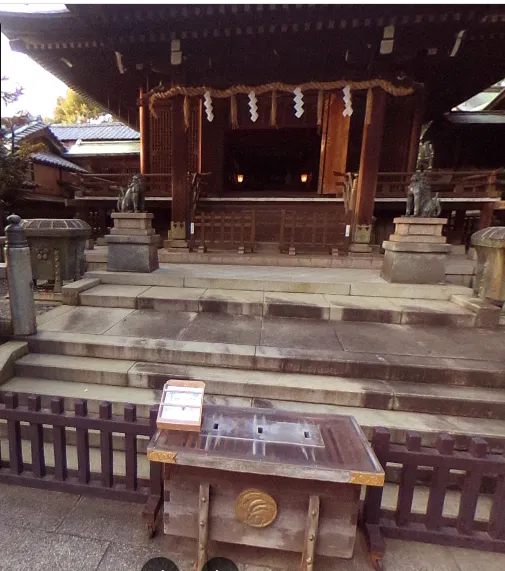
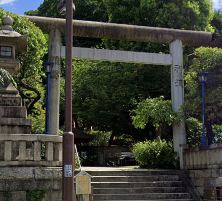
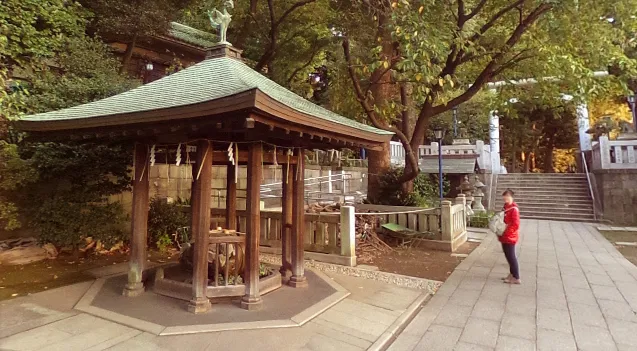
In the park you will also find a statue of a men with his dog. The gentleman in the statue was one of the people that revolted against the Tokukawas. The funny thing is, he did not get along with the main organizers of the revolt, so as officially the statue was dedicated to his memory, he was depicted in his everyday clothes just walking with his dog as an indirect way of ridicule him.
After leaving the park, you cross a section of the Ameyoko, a lively street market.
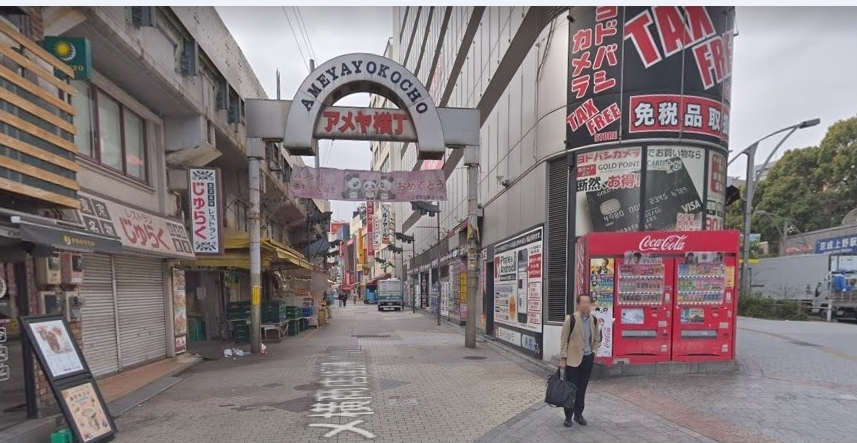
After leaving the market, go upstairs in the pic below to visit the buddhist temple of the bodisahva marishiten:
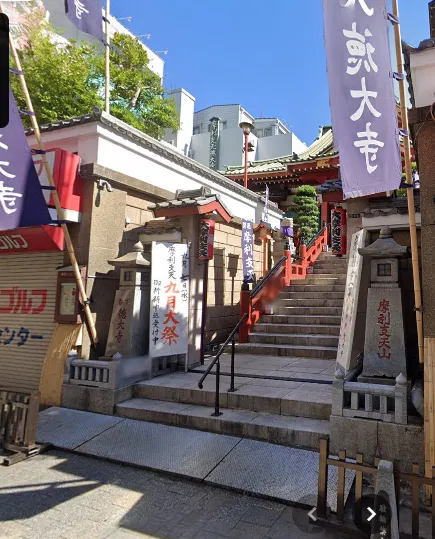
usually you will find a place to wash your hands (to purify your spirit), an altar with a box where to put coins and ask to the spirit for something. Also some temples have a traditional bell (find the places of the pics below when you go).
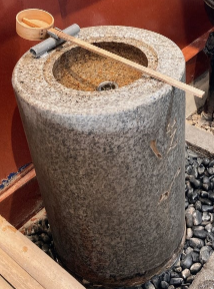

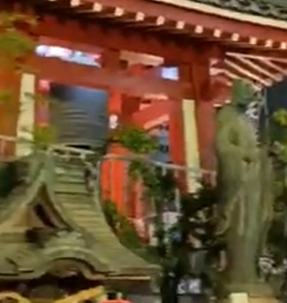
Also, some temples have at the entrance the two Nyos, a couple of muscled man that protect the place from evil spirits. If you follow this guide when visiting the big Budda of Kamakura at the entrance you will see their Nyos like below:
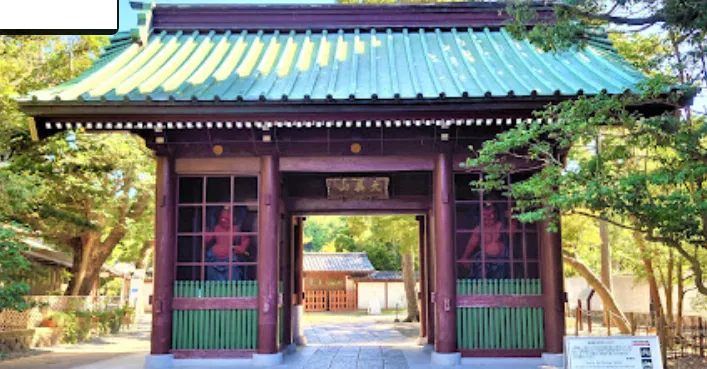 The end of the walk is at the entrance of the Iwasaki family mansion, a mansion that is mainly built in 19 century European style, however, the must visit area is the part of the house built on traditional japanese style:
The end of the walk is at the entrance of the Iwasaki family mansion, a mansion that is mainly built in 19 century European style, however, the must visit area is the part of the house built on traditional japanese style:

Itinerary One, second Walk:
Yurakucho Station -> Ginza area -> Tokyo station
map here:
https://www.google.com/maps/dir/Y%C5%ABrakuch%C5%8D+Station,+2+Chome+Yurakucho,+Chiyoda+City,+Tokyo+100-0006,+Japan/Ginza+Sony+Park/35.6714622,139.7652118/35.6747764,139.7686772/35.6818359,139.7658156/@35.6718984,139.763024,19z/data=!4m17!4m16!1m5!1m1!1s0x60188be5454f4cd5:0xb887d7273136016a!2m2!1d139.7628199!2d35.6749187!1m5!1m1!1s0x60188ba6c71b7dbb:0x85ed5d3645509f25!2m2!1d139.7631314!2d35.6721304!1m0!1m0!1m0!3e2
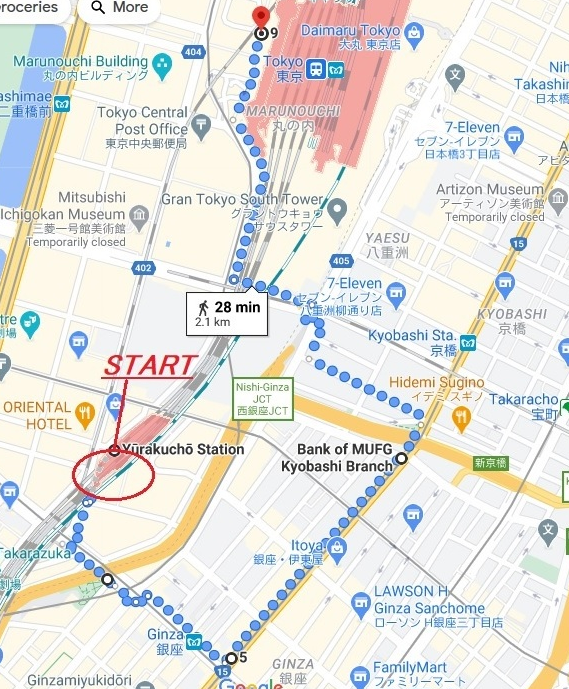
The route starts at Yurakucho station, and from there soon enters into Ginza, which is one of the areas in Tokio for expensive shops. Make a little of window shopping and if you feel like that, buy some Cartier diamond. The walk ends in front of one of the access points to Toyo station, the country main train station which also includes a very expensive hotel.
Itinerary One, third Walk: Akihabara
Route map here:
https://www.google.com/maps/dir/35.6982196,139.7723374/35.6984363,139.7712584/35.6988502,139.7705397/35.6996692,139.7708917/35.7008969,139.77141/35.7009318,139.7721771/35.6992118,139.7744328/@35.6997912,139.7700714,17z/data=!3m1!4b1!4m2!4m1!3e2
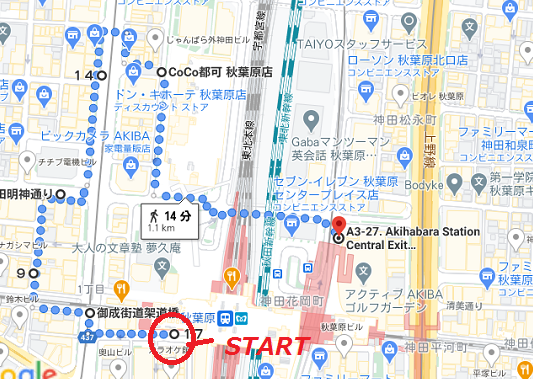
After Second World War, Akihabara district became the place where fans of electronic devices gathered to do their shopping. However, from the 80s, Akihabara turned into a place where lovers of Manga and Anime (called otakus) do their shopping.
Eventually, otakus develop a couple of curious hobbies: maid cafes and being fans of aidoru musical groups (look in google for japanese idol groups).
While you walk you will find girls giving pieces of paper, they are asking you to go to their maid cafe (for example, http://www.cafe-athome.com/en/) . A maid cafe is, well, a cafe where the waitress are young girls dressed as maids, there seems to be some manga inspiration for this but I am not interested in manga or anime so there is not much I can say, if you wanna try, go ahead. While you walk be alert to notice the green building below. As far I remember this shop (kotobukiya) is one of the most famous for anime and manga dolls, there are several floors with all kind of toys so take a look.
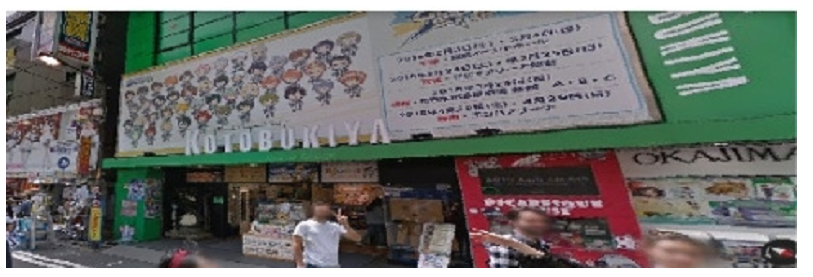
The last point of the walk is Yodobashi big camera, which is one of the biggest electrodomestic shops in the world, enter into the building and take a look to the different areas in each floor.
Once the visit to Akihabara is over, I still propose below a short fourth walk for this day , which is basically going to see the building called Roppongi Hills, but if it is already late and you are tired, you can conclude the visits for this day after Akihabara and visit Roppongi hills on other day that I propose to visit an area called Nikko if you also plan to do the Nikko day (after visiting Nikko, go directly to Roppongi hills on the return train. Also, buy some drink (with screw cap) and some snacks (that are not smelly) at one of the 24 hours open small shops around Nikko station and eat them inside the train so you just arrive to Roppongi hills, take a look, and go to your hotel without having to stop at some place for dinner ).
Itinerary One, fourth Walk: Roppongi Hills
Find a way of going to roppongi staton and from there, search on google maps or ask about roppongi hills. Roppongi is the district were Americans lived after the II world war (actually, I do not like Roppongi as it has a noveau rich ambient). Roppongi Hills is a huge building with an interesting architecture, so take a look.
Itinerary one is over, however, since I do not know your moving speed, if you still have the energy and the time and you are thinking what to do, you can look at the added days section at the bottom of this page and you will have lots of suggestions if you still do not want to go take a rest at the hotel before dinner (but notice that from afternoon most of the touristic places are closed, check with google for details). 4 interesting options are the korean town in shinOkubo, Nakano Broadway, the Odaiba area, the book town of jimbocho, the kitchenware town of kappabashi and the gay zone at Shinjuku 2 choume (https://en.wikipedia.org/wiki/Shinjuku_Ni-chōme , it seems to be that there are some bars that open from 18 hours like AiiRo cafe and Eagle Tokyo, never been in the area but maybe is a good place to mix with the locals) . Anyway check the internet for korean town in shinOkubo, Nakano Broadway, kappabashi, jimbocho, the Odaiba area, and Shinjuku 2 choume ans see if there is something interesting for you.
Itinerary Two (starts in Ishikawacho station):
For this itinerary you only have to be careful with the closing time of the included observatory deck and of course avoid a day when is not opened (https://www.yokoso.metro.tokyo.lg.jp/en/tenbou/). Also, most of the shops on Takeshita street (on the last walking of the day explained below) close around 20 hours.
Itinerary two, first walk: Yokohama Chinatown
Find a way to go to JR Ishikawacho station
https://www.google.com/maps/place/Ishikawachō+Station/@35.4387859,139.6408246,17z/data=!4m5!3m4!1s0x60185ce68e7c4309:0x56dfd53aed040e69!8m2!3d35.4387859!4d139.6430133
From the station, using google maps, go to Emperor Guan’s Shrine (also called kanteibyou). Once there, you find yourself in the Chinese district of Yokohama, full of Chinese restaurants and shops for take out food (the temples usually open at 9:30, so you can arrive a little before that), the chinese town is not big, so if you go from kanteibyou to the quite close masobyo temple you basically cross the centre of the town. After visiting the masobyo, your walk is completed (as in any place of this guide, look on google for information about this two shrines)
Itinerary two, second walk: Shinjuku golden gai -> Kabukicho -> Traditional street -> Observatory deck of metropolitan government building
Find your way to Shinjuku station and start the walk. Map here:
https://www.google.com/maps/dir/Shinjuku+Sta.+Higashiguchi+(East+Exit)/35.6948599,139.7019125/%E3%80%92160-0021+%E6%9D%B1%E4%BA%AC%E9%83%BD%E6%96%B0%E5%AE%BF%E5%8C%BA%E6%AD%8C%E8%88%9E%E4%BC%8E%E7%94%BA%EF%BC%91%E4%B8%81%E7%9B%AE%EF%BC%91%EF%BC%94/35.6937303,139.7049426/35.6956483,139.7034681/35.6959656,139.7017812/35.6938483,139.7010087/35.6934018,139.6995994/35.6926383,139.6997684/@35.6934595,139.6984058,17z/data=!4m21!4m20!1m5!1m1!1s0x60188cd7566a00cd:0xf44a154a541d03bf!2m2!1d139.70125!2d35.692448!1m0!1m5!1m1!1s0x60188cd9cd715ad5:0xba3fc99ba9c83442!2m2!1d139.7020666!2d35.694497!1m0!1m0!1m0!1m0!1m0!1m0!3e2
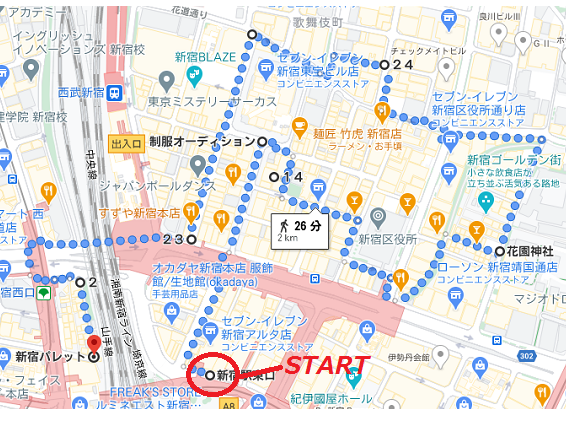 Soon the walks enters in the area called golden gai, which has many small bars with a 70s rock feeling.
Soon the walks enters in the area called golden gai, which has many small bars with a 70s rock feeling.
 Most of the time, the walk cross some streets of Kabuchicho. This is the red light district in Tokyo. You will find clubs with pictures of young guys in the entrance. Those are the host clubs, where a young guy will pour the drinks and give conversation to his female client (sex is not expected, but if you are a regular client and spend a lot of money you may get a little of “thank you” sex on the side). The curious thing is that the main clients are the hostess, that is, the female version of these clubs. Basically, the Tokyo male workers go to hostess clubs where they pay a lot of money to the girls that pour the drinks and do the talking, and with the money they make, the girls go to this host clubs where they became the client. Also, in this area you cand find love hotels, places where you can rent for hours rooms for couples.
Most of the time, the walk cross some streets of Kabuchicho. This is the red light district in Tokyo. You will find clubs with pictures of young guys in the entrance. Those are the host clubs, where a young guy will pour the drinks and give conversation to his female client (sex is not expected, but if you are a regular client and spend a lot of money you may get a little of “thank you” sex on the side). The curious thing is that the main clients are the hostess, that is, the female version of these clubs. Basically, the Tokyo male workers go to hostess clubs where they pay a lot of money to the girls that pour the drinks and do the talking, and with the money they make, the girls go to this host clubs where they became the client. Also, in this area you cand find love hotels, places where you can rent for hours rooms for couples.
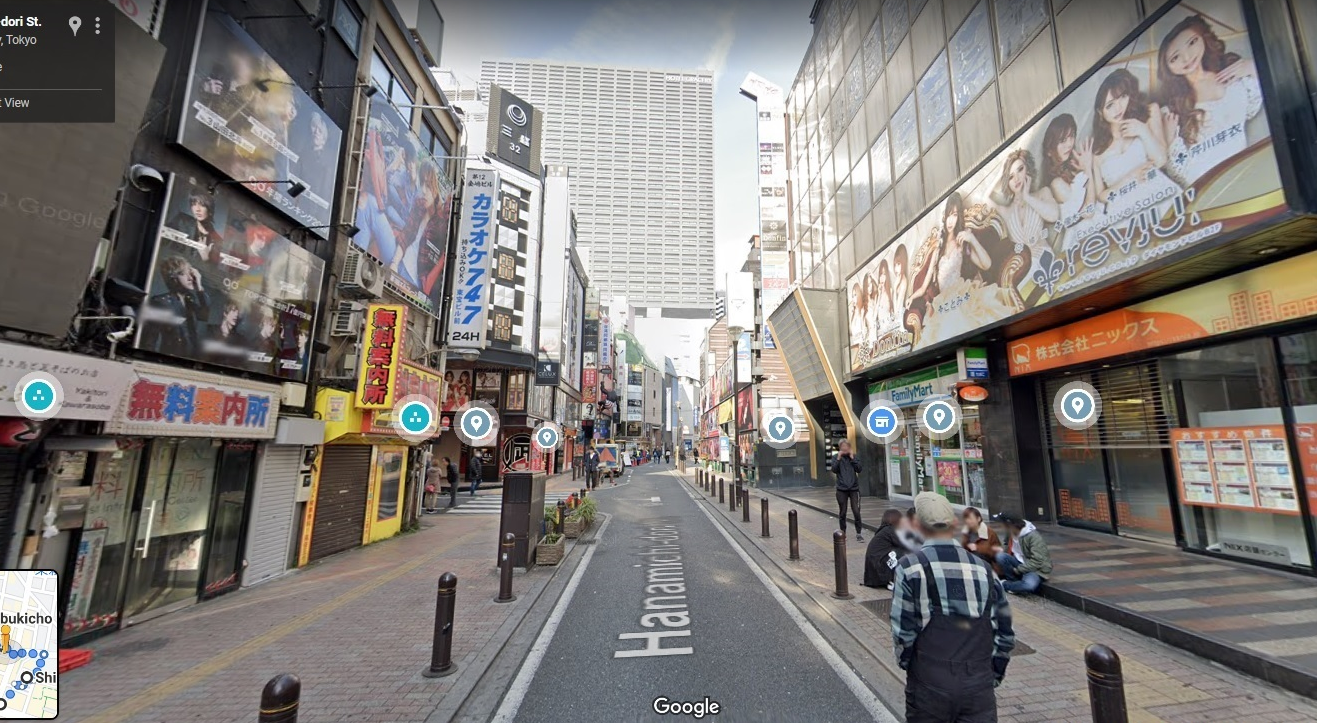
The walk ends in a traditional narrow street full of typical small restaurants.
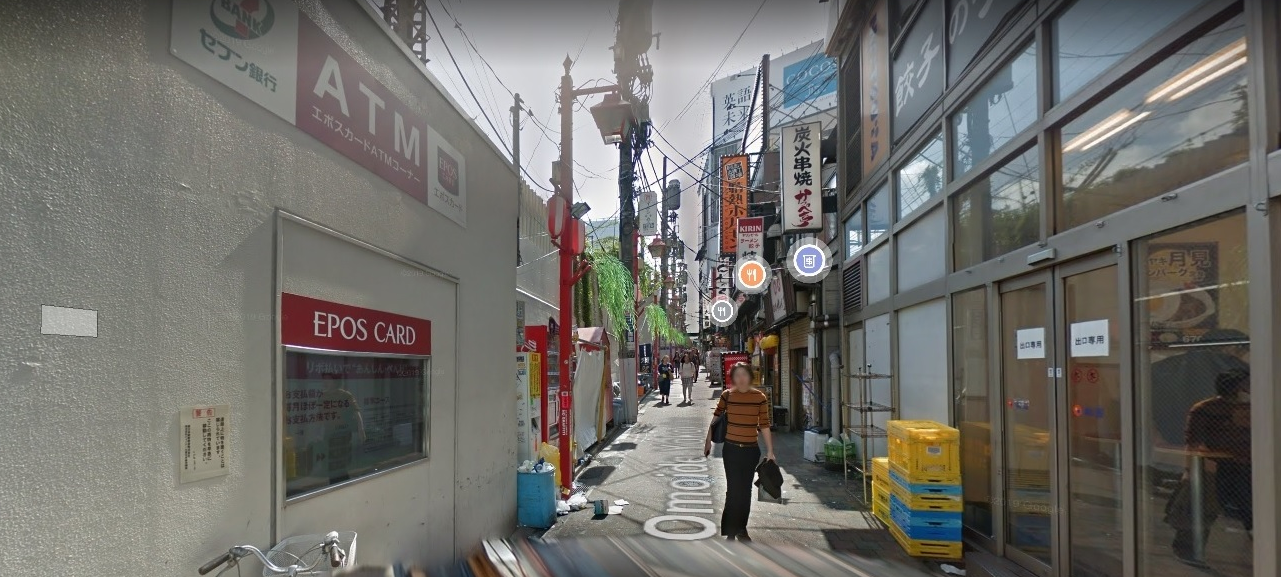
After the walk ends, walk to the Tokyo prefectural building
https://www.google.co.jp/maps/place/%E6%9D%B1%E4%BA%AC%E9%83%BD%E5%BA%81/@35.6896161,139.69205,19z/data=!4m8!1m2!2m1!1sedificio+prefectural+tokio!3m4!1s0x60188cd4b71a37a1:0xf1665c37f38661e8!8m2!3d35.6896342!4d139.6921007?hl=ja , a big building with two towers. Each tower has on top and observatory, choose one tower (or the only one with the observatory open) and ask until you find the elevator to the observatory desk. Day or night, the views are great.
Itinerary Two, third walk: Shibuya -> Harajuku
Map here:
https://maps.app.goo.gl/FfGKgA6zPiZNrYiJ6?g_st=ac
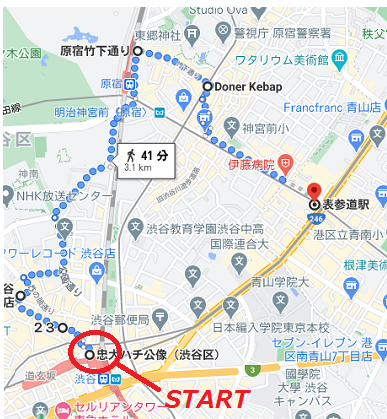
Find a way to arrive to Shibuya Station and leave from Hachiko exit. There you will find the statue of the Hachiko dog (walk starting point) (google it if you never heard about that). From there walk to Harajuku district, where young people buy their clothes. There is specially famous street called Takeshita full of cute shops.
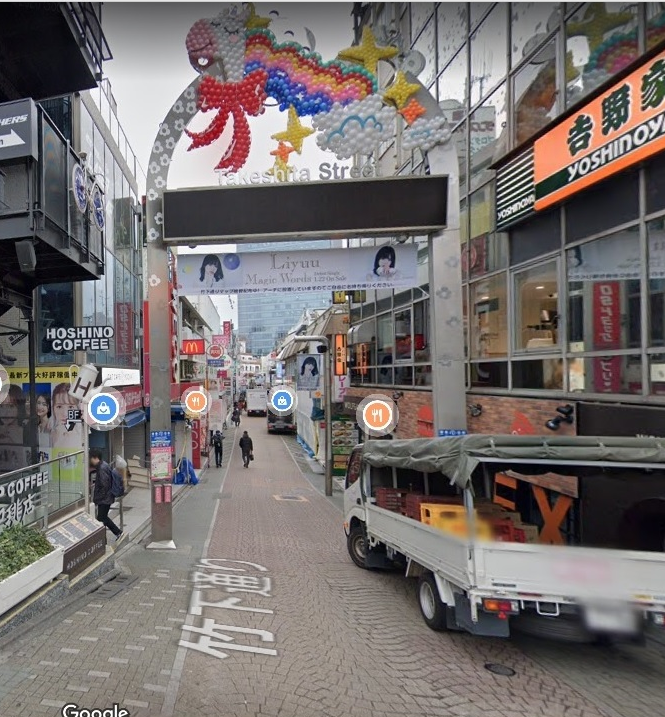 After that, you go to Omotesando street where you can also find a lot of european clothes shops. The walk ends there in front of a couple of buddisht statues of Nyos.
After that, you go to Omotesando street where you can also find a lot of european clothes shops. The walk ends there in front of a couple of buddisht statues of Nyos.
Itinerary two is over, however, since I do not know your moving speed, if you still have the energy and the time and you are thinking what to do, you can look at the added days section at the bottom of this page and you will have lots of suggestions if you still do not want to go take a rest at the hotel before dinner (but notice that from afternoon most of the touristic places are closed, check with google for details). 4 interesting options are the korean town in shinOkubo, Nakano Broadway, the Odaiba area, the book town of jimbocho, the kitchenware town of kappabashi and the gay zone at Shinjuku 2 choume (https://en.wikipedia.org/wiki/Shinjuku_Ni-chōme , it seems to be that there are some bars that open from 18 hours like AiiRo cafe and Eagle Tokyo, never been in the area but maybe is a good place to mix with the locals) . Anyway check the internet for korean town in shinOkubo, Nakano Broadway, kappabashi, jimbocho, the Odaiba area, and Shinjuku 2 choume ans see if there is something interesting for you.
Outskirts/Traditional Tokyo
Itinerary One: Nikko.
For this itinerary apparently every day the places to visit are opened, but check on the internet if something is closed for the day you want to go. I will not put a google map for this as all the destinations are very easy to find. In Nikko there are 4 sites that I propose to visit (Tosho-gu, Futarasan, Nikkosanrinnoji Taiyuin and Rinnoji temple), all the sites are about 3 minutes walk from each other, but make sure to arrive at the latest 1 hour before closing to the last place to visit which is the Rinnoji temple (check the closing time for your day of visit).
The first Tokukawa that became Shogun, ordered all the clan leaders to put money to built an amazing temple, the Tosho-gu (entrance), using Chinese decoration and putting it in the middle of a beautiful forest.
Nikko has 2 train stations (the one for the Seibu train company is called Tobu-Nikko and the one for the JR train company is called Nikko), you can plan how to get there using Google Maps, try to arrive at the Nikko station no later than from 10:30 in the morning, for which you will have to get up very very early.
Of the many ways to get to Nikko, my proposal is the cheap version (although you can search for all kinds of ways to go on the internet). For example, find a way to get to the kita-senju station and at that station enter the area of the Seibu Tobu train lines by buying the cheapest ticket (it will be about 150 or 180 yen). Once inside the station, use Google Maps directions to get to Tobu-Nikko station (avoiding the special trains that cost extra money). With normal trains, from Kita-senju normally you arrive at a station called Minami kurihashi and from there you change to another train (probably having to change once more) until you reach Tobu-Nikko. Once in Tobu-nikko, show the ticket that you bought in Tokyo to the attendant at the station exit and he will tell you to pay him the equivalent of about 9 or 10 euros/dollars.
As Google Maps will tell you, to get to Nikko before 10:30 with the combination I have suggested you will probably have to be in Kita-senju before 7:30, so you can buy in kita-senju some drink (with screw cap) and some snacks (that are not smelly) at some of the 24 hours open small shops that are always around train stations and take them as breakfast inside the train.
To return to Tokyo in the evening do the reverse process, buy the cheapest ticket that allows you to access the trains at Tobu-Nikko station and continue until at least Kita-senju.
From the station, you can walk 30 minutes in a pleasant stroll to the Tosho-gu (i dont remember well but maybe there are not restaurants in the temples area, bring some snacks for lunch that you can buy at any train station convenience store, you can seat to eat in the following open area which also has a public toilet in front :
https://maps.app.goo.gl/XorowPz96Vn9WvsbA).
After visiting the Tosho-gu , walk some minutes to a complex of small Shinto shrines called Futara san and visit the Nikkosanrinnoji Taiyuin, a temple that includes the tomb of the grandson of the founder of Tokukawa shogunate and is created in the same style as Tosho-gu . To conclude the visit, go to the Rinnoji Temple (check on the net beforehand the last entry time ) , inside the temple you can see 3 big statues, the center statue I think is Siddarta, to the right is the bodisaba Kanon and to the left the bodisaba Shiva, the visit also includes a small museum with some sculptures and a small garden behind). When you arrive back to Tokyo, if you still have the energy and the time and you are thinking what to do, you can look at the added days section at the bottom of this page and you will have lots of suggestions if you still do not want to go take a rest at the hotel before dinner (but notice that from afternoon most of the touristic places are closed, check with google for details). 4 interesting options are the korean town in shinOkubo, Nakano Broadway, the book town of jimbocho, the kitchenware town of kappabashi, the Odaiba area, and the gay zone at Shinjuku 2 choume (https://en.wikipedia.org/wiki/Shinjuku_Ni-chōme , it seems to be that there are some bars that open from 18 hours like AiiRo cafe and Eagle Tokyo, never been in the area but maybe is a good place to mix with the locals) . Anyway check the internet for korean town in shinOkubo, Nakano Broadway, jimbocho, kappabashi, the Odaiba area, and Shinjuku 2 choume ans see if there is something interesting for you.
Itinerary Two:
Traditional Japanese garden called Kyu Shiba Rikyu Gardens ->Big buda statue ->Odawara castle -> Stay at a tatami (straw panels floor) room of an hotel with communal bath area in Atami or Hakone-Yumoto area (all the places seem to be opened everyday but check on internet for your desired day, just be careful with the last entry time to the Odawara castle, if you are short of time buy some not smelling snack in some train station convenience store and take it for lunch inside the train ).
As that night you stay in a hotel in the outskirts of Tokyo, when you check out in the morning at the hotel where you have been previously staying, ask if you can let your suitcase until the next day morning. If they cannot do it for you, there many options close to city main train stations (https://tokyocheapo.com/living/luggage-storage-in-tokyo/) , best option seems to be at Tokyo train station but check about that (
https://www.sagawa-exp.co.jp/ttk/english/service/tenimotsu.html) . When you left your suitcase, do not forget to put some clothes in your backpack for the night.
As for the itinerary, first go to the Kyu Shiba Rikyu Gardens. Usually opens at 9:00 every day.
Wake up early in the morning, leave the big suitcase at some place, have breakfast, and be in front of the garden a little before 9 in the morning (search previously on the net that that day it will be open at 9:00).
After visiting the garden (20~30 minutes should be enough), you can go to the very near JR Hamamatsucho station and from there go to the kamakura station (1 hour from the center of Tokyo), There take the enoden line (different train company, but there is a connecting gate without having to leave the JR station) and leave at Hase station. From there you probably will not need to check google map as it is very easy to find the Big Budda, just a 10 minutes walking.
After that, go back to JR kamakura station and from there go to Odawara station (another hour). Leave the station and walk 10 minutes to the Odawara castle.
After visiting the castle, if you have the time and energy, you can walk 20 minutes and visit Matsunaga house, the house of a XX century tea ceremony master and electricity company CEO. The house is built in traditional japanese style and has a very beatiful garden:
https://www.google.com/maps/place/%E6%9D%BE%E6%B0%B8%E8%A8%98%E5%BF%B5%E9%A4%A8%EF%BC%88%E5%B0%8F%E7%94%B0%E5%8E%9F%E5%B8%82%E9%83%B7%E5%9C%9F%E6%96%87%E5%8C%96%E9%A4%A8%E5%88%86%E9%A4%A8%EF%BC%89/@35.249034,139.1363297,16z/data=!4m6!3m5!1s0x6019a48ab95f25ad:0x2d003ce4be5491ea!8m2!3d35.249034!4d139.1414791!16s%2Fg%2F122c669_?entry=ttu
After visiting the house, if still there is energy and time, another 20 minutes walking will take you to a factory where they made kamaboko (a traditional japanese snack made from fish grinded meat) :
https://www.google.com/maps/place/%E9%88%B4%E5%BB%A3%E3%81%8B%E3%81%BE%E3%81%BC%E3%81%93%E5%8D%9A%E7%89%A9%E9%A4%A8/@35.245446,139.110834,15z/data=!3m1!5s0x6019a47d91cf5efd:0x6a0674153f977383!4m10!1m2!2m1!1shakubutsukan!3m6!1s0x6019a47d9107ee93:0xe97bfabfcc0876a9!8m2!3d35.2454456!4d139.1288588!15sCgxoYWt1YnV0c3VrYW5aDiIMaGFrdWJ1dHN1a2FukgEGbXVzZXVt4AEA!16s%2Fg%2F1tld06y1?entry=ttu
(in the improbable case that you have the time and energy, after the factory visit just 10 more minutes of walking will take you to a interesting natural history museum: https://www.google.com/maps/place/%E7%A5%9E%E5%A5%88%E5%B7%9D%E7%9C%8C%E7%AB%8B%E7%94%9F%E5%91%BD%E3%81%AE%E6%98%9F%E3%83%BB%E5%9C%B0%E7%90%83%E5%8D%9A%E7%89%A9%E9%A4%A8/@35.245446,139.110834,15z/data=!3m1!5s0x6019a37fd2c34f3b:0x34fa9c6c8ee5ff30!4m10!1m2!2m1!1shakubutsukan!3m6!1s0x6019a37e33ab419b:0x64c70a92b1dbbfb8!8m2!3d35.2394963!4d139.121663!15sCgxoYWt1YnV0c3VrYW5aDiIMaGFrdWJ1dHN1a2FukgEWbmF0dXJhbF9oaXN0b3J5X211c2V1beABAA!16s%2Fg%2F123199fb?entry=ttu)
After the tourist time is finished, go to Atami (in the coast) or Hakone-Yumoto (at the mountains), a couple of small towns located in an area of hot springs. Make sure you reserve a traditional room with tatami floor in a hotel that also has a communal bath area where to enjoy a traditional Japanese bath. If you look on the internet is easy to find information about that kind of hotels, how to make a reservation and how to behave in the bathroom area. For example a quick search at agoda.com close to Atami station gives me as result hotel Atami New Fujiya, and at Hakone-Yumoto if found Hakonenomori Okada Hotel (20 minutes walking to station with a nice path following a river). Never have been at those hotels but just by looking at the pics I can say that is the kind of places Japanese people go. Reserve a room with tatami floor, sleep with a futon and take a bath at the communal bath area (women and men areas separated). If you reserve in advance for a weekday with no dinner and no japanese breakfast , you can find a room around 100 euros (specially in Hakone, rooms are usually far more expensive but include a nice dinner and a traditional japanese breakfast, if you prefer the expensive way go for it). Also, the following day you can go back from Odawara station to tokyo station in a bit more of half hour with a high speed train (shinkansen) for around 30 euros if you want to say that you took a japanese bullet train, but those trains are just the same as other countries high speed trains.
Added Days
Added days:
So far I have given plans for 4 days in total, but I also commented at the top of the page that for a trip of no more than two weeks you can concentrate the whole trip in the Kanto area (Tokyo and surroundings).
For example, if you travel nine days in total (from Saturday to Sunday of the following week), you have to count that the planes will take you between 3 and 4 days if you intend to go from Europe or America, so as I have given 4 days of plans you will have two more days in which to do whatever you have always wanted to eat/shop/do in Japan or any of the options I give at the bottom of this page.
I have said that you can have plans in the Kanto area for up to a total trip of 14 days (10 days of actual sightseeing). For example, for a 2 week trip, you can do the following (I explain in detail what each thing at the bottom of the page):
In addition to the 4 days with the basics I have explained, you can use one day to hike in the mountains, one day to visit Kawagoe, one day to visit an amusement park, one day to visit Enoshima, one day to visit more traditional areas of Tokyo (first in the morning go to Taishakuten temple in Shibamata area (the surroundings of the temple are also interesting, search on internet), then visit zojoji temple, then go to Meiji jingu shinto temple, and if you have time visit also Yasukuni shinto temple (this temple has a small museum in honor of the fallen fighting in the japanese army) and asakusa buddhist temple), and the tenth day leave it for things you want to do/buy in japan (if there are not, search in internet what other things you can do that day, for example, watch a local soccer or baseball or basketball game or attend some music concert).
for anything mentioned below, you can found plenty of information on the net, these are the basic options:
1)Whatever specific thing you ever wanted to do in Tokyo (that includes some dish you want to eat in Japan)
2)Shopping, like "1)" above, if there is anything you ever wanted to buy in Tokyo, go ahead.
3)More traditional buildings:
For big versions of shinto shrines: Meiji Jingu shrine and Yasukuni shrine
For buddhism temples : Taishakuten temple in Shibamata and Zojoji temple.
Also Asakusa temple is very popular.
4)Museums:
Mi recommendation is to visit an open air museum showing Japan arquitecture examples ( https://www.tatemonoen.jp/english/) and the Edo museum where you will learn the history of Tokyo city: http://www.edo-tokyo-museum.or.jp/en/p-exhibition/
You can go to Ghibli museum if you like Miyazaki movies (never been there, but I heard you need to to make reservations in their webpage) .
5)One day excursions:
You can go either to Kawagoe ( https://www.theinvisibletourist.com/kawagoe-day-trip-itinerary-from-tokyo/ , https://www.japan-guide.com/e/e6500.html)
or Enoshima (https://www.japan-guide.com/e/e3117.html)
6) For some walking in the mountains, you have plenty of information on the internet: https://tokyocheapo.com/entertainment/tokyo-hiking-trails/ (you can also climb mount Fuji in summer, look on the internet for an explanation about that if you are interested).
7)Amusement parks: https://www.japan-guide.com/e/e2067.html
8)Traditional gardens and parks: https://www.japan-guide.com/e/e3034.html (I like Todoroki valley, but be aware is just a 5 minutes walking, not really a valley)
9)Internet is full of Europeans and Americans that love to explain their lives in Japan or at least their travels all over the country, look for blogs and guides and surely you will find something interesting to do.
And that is all, Have fun.

google416f14f4ac7d87e7.html
Welcome to the best essential guide of Japan (of course, the title is ironic, all guides more or less offer the same), my name is… irrelevant. Let’s just say I am someone who has been living for a long time in Tokyo and, having to spend a couple of boring days in bed with an sprained ankle, decided to put together his advice about visiting the city.
Japan, Tokyo, Kyoto…of course, for a westerner, Japan is one the most desirable tourist destinations. All the oriental mysticism and exoticism minus the sometimes questionable hygiene and the constant fear of food poisoning or being robbed or swindled at every corner. Actually, Japan probably fares better than your country in all the things a tourist wants, which basically are excellent public transportation and locals don’t shouting at you (actually, the fact that English does not seem to be very useful just add more cuteness to the locals). Furthermore, we are talking about Japan, one of the pillars of modern popular culture, crazy Japan, that Japan that blends tradition and technological hyper modernity, so who does not want to visit at least once? (by the way, the average Japanese is as dull as your neighbor next door, crazy Japan is just the result of picking out of context the small percentage of freakish things that every society has, and amplify them trough the internet and TV). Of course, living here is a very different matter, but that is not the object of this page.
The information given here is more or less accurate by the time I am writing this, which is the fall of 2018 (update: i read again the page again in January 2025 and made a few small changes, so the definitive version is for January 2025). By the time you are reading it, it could be the case that Martians have already obliterated the whole Japan, so take into account that things could be a little different when you go to Tokyo.
---------------------------------------------------
First, let's consider the general plan for visiting Japan.
Starting from the almost inevitable principle that if you travel to Japan you must visit Tokyo, the 3 basic options that are usually considered for a first trip to Japan are as follows:
Option A) See only the Kanto area (Tokyo and surroundings).
Option B) See the Kanto area and the Kansai area (Kyoto, Nara and Osaka).
Option C) See the Kanto area and other areas of the country (including the Kansai area or not).
Of the 3 basic options given above, there are two tips I can give:
Tip 1 (written in 2025):
As of today, the Kansai area has unfortunately degraded touristically, so is better to avoid the option B above. Especially Kyoto is a relatively small city and the huge influx of foreign tourists has the effect that visiting it can be a bit disappointing (lately this is an opinion I have heard from all groups of friends who have visited Japan, besides becoming a common opinion among foreing residents).
Tip 2:
For a trip of no more than two weeks, the Kanto area (Tokyo and surroundings) is enough to have a tourist experience of the same quality as making the effort to travel to several remote areas of the country. Moreover, in this case you will not only save the stress of moving hundreds of kilometers carrying a suitcase, but you will also save a great deal of money.
In fact, this tourist guide is focused on Tokyo, in this page we propose you how to visit Tokyo and surroundings and we will give you plans to occupy a trip of up to two weeks.
If your travel plan is longer than two weeks, you can spend the first two weeks in the Kanto area as explained on this page and leave the extra time to travel to other areas of the country. If you wish to plan days in areas beyond Kanto, for example, you can consult https://www.japan-guide.com/.
Also, if you are planning a long trip of several weeks you will have heard about the Japan Rail Pass. Nowadays, the Japan Rail Pass has become so expensive that in most cases it is not worth buying it (especially for a trip of no more than two weeks without leaving the Kanto area as I recommend, buying this pass becomes a waste of money).
-----------------------------------
Now, let’s consider a few things before the travel
– Weather (what clothes do I put in the suitcase?):
OK, I’m not going to make any explanation about that, just check the Wikipedia entry (https://en.wikipedia.org/wiki/Tokyo). The only thing I am going to say is that summer is Asian humid hot (although not crazy humid hot as Thailand or Vietnam), so if you travel in summer, prepare to sweat a lot. In fact, I will add as a comment from 2025 that given the rising temperatures, from mid-July to early September tourism is simply not advisable, spending long periods of time outdoors at that time is an invitation to have a heat stroke.
– Money
As stealing and robbing is less usual than other countries, and because of other reasons, Japan is still a very cash oriented country (to the desperation of the Japanese Government). The situation has been improving, but still some restaurants and shops are cash only, and credit cards from outside Japan sometimes are not accepted by the machines here.
I remember a German guy who came just with his credit cards (probably linked to his Deustche Bank account) and zero money. Lets just say that he found the hard way that it can be problematic in Japan if you do not have cash.
In Japan you can carry a lot of cash in your bag and still be safe (as long as you don’t forget it in the bathroom of a restaurant or left it unattended in some place). My advice is to check the exchange rate for your euros or dollars at the money exchange offices in the Japanese airport where you plan to arrive (probably Narita airport:https://www.narita-airport.jp/en/service/svc_11) and, unless you can find a better deal at your home, change to yens there (by the way, leaving aside the airplane ticket, this travel budget is not expensive at all, lets put 60 dollars/euros per hotel night (so 30 if you share room with a travel partner) and add to that a daily average cost of 30 dollars/euros for trains and museums and 20 for food, that means 80 dollars/ euros per person per day).
– Crime
Japan is a country where the majority of criminals are concentrated in other type of crimes rather than pickpocketing or robbing at gun point, which means that for a tourist like you is pretty safe as long as you follow the same precautions you use at home. However, that does not mean that if you do something stupid you will get a free pass. For example, in this guide you pass trough the red district of Tokyo, called Kabukicho. Basically, you can walk at midnight in Kabuchiko waiving a stack of 10000 yen bills and you still would be probably safe(only in the sense of not being robbed), but if you think that is a good idea to take a picture of some tattooed guy in Kabukicho, you will probably find your camera smashed to pieces. And if you think you want to start a fight about that, the cops will arrest you as all the witness in the area will assure that you are the bad guy (regardless of what you consider to be the truth). The bottom line is, remember not to do anything stupid and you will be fine.
– Accidents and Illness
In principle, hospitals in Japan are private, that is, 100% operated for profit. That means that if you ever have to go to one, after getting treatment, you will be taken to the payments counter and expected to pay for absolutely all. Most of the people living in Japan show at the payments counter their national insurance card, which will waive you 70% of the money, but since you do not have one of this cards, expect to pay 100%. Of course, if you have a travel insurance, you can ask a repayment to the insurance company when you are back to your country. However, as far as I know, your average Japanese hospital only makes its bills in Japanese, so you are going to have a lot of fun when dealing with your insurance company. Anyway, it would be a good idea to bring in your wallet the directions of a couple of English speaking hospitals in Tokyo (just look in Google).
– Electricity
Like weather, this is something I will not comment in detail. Just do not forget to check on Google what kind of plug adapter you need to bring from your home if you intend to use your own electrical devices (https://www.japan-guide.com/e/e2225.html).
– Internet and Smart phones
For the reasons I will explain later on, you will need a smart phone with 24hours capacity of connection with the internet when following my guide. Also, buy or lend a couple of portable batteries for the phone with their respective cables (with the phone connected to google maps all day, soon the phone battery will dry out) and also a multiple outlet extension cord with 3 entries (the hotel will not have many outlets, so every night use the extension cable to let charging all night the phone and the two batteries at the room).
If you use your smart phone with your local carrier in Japan, be careful with not finding a huge bill of thousands of euros/dollars when going back home. You can compare your local carrier prizes for using your smart phone abroad with the prize of renting a SIM card or a smart phone at the Japanese airport from where you arrive to Japan and decide what is better for you (https://www.narita-airport.jp/en/service/svc_19).
– Hotels
My advice for finding a hotel in Tokyo is as simple as opening Agoda.com or whatever site you normally use to search for hotels, select all of Tokyo area (with only hotels), and search starting from the lowest prices (making sure you choose a private room with a private bathroom).
Regarding the position of the hotel, forget about whether it is in X or Y neighborhood, the trick is to look with google maps how long it takes to get from the hotel to any of the Yamanote line stations (you can check the list of stations here: https://en.wikipedia.org/wiki/Yamanote_Line ) and if you find at least one station to which it does not take more than 45 minutes to arrive, the position of the hotel is acceptable.
With the above search pattern, you should be able to find a room for two people in the price range of 50~70 euros per night per room. Be aware beforehand that the room will be very small (compared to what is usual in the West) but do not worry about hygiene (hotels in Japan are usually very clean). You will also sometimes find that you are offered what used to be “love hotels” (hotels by the hour for couples) or even hotels that are still mainly for couples (“adult only” hotels), in this case the hygiene standards are as good as ordinary hotels, the security just as good, and the room sizes usually larger (and wooden partitions at the windows) so is not an option you should avoid.
I cannot say anything about hostels as I never tried and capsule hotels are not an option for you. Airbnb type private renting was a popular option until the government created a law where in theory is possible to rent an apartment but in practice is very difficult, but you can check and see if there is anything that seems to suit you.
– Trains
With a massive city of tenth of millions of people moving every day, the urban train and metro transportation is not huge but also the only practical way to cover relatively long distances when moving in the city.
There are dozens of train and metro lines operated by different companies, but the good news for you is that the itineraries given in my guide mainly use the biggest stations of the JR (Japan Railways) company which are quite easy to access.
At the entrance of any station, you can find the ticket machines where you buy a ticket for any amount of money that you want. The more expensive ticket you buy, the more far away are the stations you are allowed to get out from the station you bought the ticket. For example, if you are in JR Tokyo station and want to leave from Shibuya Station, you need to buy a 210 yen ticket (the price for each station counting from the station you are is written in a big map above the automatic vending machines). Once you have your ticket, go through the ticket check point and insert it in the control machine (of course do not forget to take it while you are entering the station). Which combination you use to go from Tokyo to Shibuya is up to you (but is not difficult to decide it if you carry a map of the stations). When you arrive to Shibuya, just put the ticket in the control machine and leave the station (the machine will keep the ticket).
Of course just with this confusing explanation you are thinking right now that is going to be difficult to use the train in Tokyo. But once you try there you will see that is pretty easy. Just remember the basics given in this explanation.
By the way, here is a map of JR Tokyo train stations (just keep the PDF file in your smart phone and save data use:
http://ontheworldmap.com/japan/city/tokyo/tokyo-jr-map.jpg) . Google maps do the best job calculating train routes in Tokyo.
– Food
Well, Japanese food is famous enough to need many explanations. You have to try the basics of every day Japanese eating which is ramen, udon and soba for pasta dishes plus guydon (rice with meat slices), tonkatsu (pork coated in breadcrumbs & deep-friend) , rice with curry sauce, Yakiniku (roast chicken) and tempura (fried vegetables) . And of course sushi. Whenever you want to have lunch or dinner search in Google maps for some Matsuya or Yoshinoya or Sukiya or Hidakaya or Gyoza no Ousama (chains that serve most of the dishes above). Notice that in some of this kind of places you first buy a food ticket in an automatic vendor machine and you give the ticket to the waiter. By the way, you already know, but remember that in Japan there are not tips.
--------------------------------------------------
Time to start with the travel.
As I mentioned someplace above, for this travel guide what I do in some cases is to put links to Google maps with itineraries and some comments where could be needed for each route provided on this page.
Now, if you are special forces level good at using maps, I guess you do not need to use your position localizator on Google maps (the blue dot). But otherwise, I implore/order/scream at you to make sure that you can check anytime your position in the linked Google map while you are following my itineraries and also use google street view anytime you get lost.
Also, when preparing the trip, check on the web pages of the museums and temples when are they expected to be closed so you avoid the surprise of arriving there and find that you cannot enter to the place.
For any itinerary, check in advance the given distances and calculate how much time you will need walking at your own pace. For museums give yourself at least one hour, and also give yourself and approximate time schedule including your time for lunch (look in google where you can have lunch) so you know at what time you want to be at each place. As parks and other places to sit are scarce in Tokyo, whenever you spot a MacDonald you can buy a 100 yen drink and sit for a comfortable pause. Also you can take an even more comfortable pause whenever you spot a Starbucks and the Japanese variants (Doutor, Caffe Veloce, etc), but in this case the cheapest drink is going to be 3 times more expensive than MacDonald.
If you need to go to the bathroom, you can look the closest one of the following searches on google maps: 1) just look for the word toilet and maybe you are lucky 2) Big parks usually have public toilets 3) look for convenience store (most of them have a toilet, proper manners request that after using the toilet you buy the cheapest item of the store (usually a small chocolat bar for 40 or 50 yen) as a thank you sing) 4) look for the closest train or metro station, buy the cheapest ticket (usually around 140 yen) and use the toilet after the ticket control area, when you are done just go back to the ticket control area and give the ticket to the employee, he will let you go out).
Also, for those of you that like to extend the tourism journey until late at night, be aware that in tokyo from a little later after midnight until around five in the morning there is no public transportation (and taxis are crazy expensive, better avoid them). If you lost the last train, still there you can find a macdonal, starbucks or similar that is open 24 hours and you can wait there until 5 in the morning).
----------------------------------------
The basic plan I explain below covers two days in the urban area of Tokyo (Urban Tokyo) and two days to see the best of the outskirts of Tokyo (Outskirts / Traditional Tokyo).
In the weird case that you can only have two tourist days for Tokyo in your Japan travel plan, then do the 2 days of the Urban Tokyo part, and if you only have 3 days for Tokyo area, do the Urban Tokyo part and one day of the Outskirst/Tradional Tokyo part. I leave to you to decide the concrete days order for the visits.
----------------------------------------
Urban Tokyo
Urban Tokyo consists of 2 itineraries, one itinerary per one day. You do not need to do first the itinerary one. Actually, you can mix the order of this itineraries with the Outskirts/Traditional Tokyo itineraries if you also plan to do them.
Itinerary One:
For this itinerary is better to start visiting the Tokyo National Museum at its opening time, which usually is 9:30.
Itinerary One, first walk: Tokyo National Museum -> Ueno Park (shinto shrine Goyoten) -> Ameyoko Market (Buddhist temple Marishiten)-> Traditional japanese house (mansion Iwasaki family)
The link to map is below (if your map is displayed wit car route of course change it to walking route, i put a pic below of what should be the route):
https://www.google.com/maps/dir/35.7175374,139.7755567/35.7135946,139.7723166/35.7119983,139.7740761/35.710868,139.7745241/%E6%91%A9%E5%88%A9%E6%94%AF%E5%A4%A9%E5%BE%B3%E5%A4%A7%E5%AF%BA/35.7094694,139.7683073/@35.7095756,139.767799,20z/data=!3m1!5s0x60188e9f96b44977:0xc2c08e22d80a22d!4m13!4m12!1m0!1m0!1m0!1m0!1m5!1m1!1s0x60188e9f946d5847:0xb6dffad13b23fb8d!2m2!1d139.7745549!2d35.7085662!1m0!3e2?entry=ttu

Use google maps to arrive to the entrance of the Tokyo National Museum. Pay your ticket at the fenced area and go passing the long fountain to the building below.

Climb the stairs to enter the museum and once inside , go upstairs (photo) to the upper floor and turn to the left to start the chronological expositions (where it says highlights of Japanese arts, photo). From here I am talking just from memory and I have not gone in years, but the first area has some artifacts of the first recorded cultures of japan, first the yomomji and later on the yayoi (from the last 2000 years japan has been pretty homogenize but genetically speaking japan is a big mix of the ancestors of present Koreans, Chinese, Mongols and South Asians who came in successive waves to the Japanese islands).
After that it comes the culture of the big tombs, but notice that this culture is from 3th century and Japan still lacks writing systems or other advanced cultural artifacts, however, with the tag of Nara, 7th century, you have in the same space a statue of Buddha superbly created and documents written with Chinese characters.
What happened was that, after millenniums of poorly advanced cultures, in the 5th century a clan near to actual Osaka called the Yamato where able to subjugate most of the other clans on the islands, and the Yamato decided to invite Chinese Buddhist monks and Korean nobility to live in Japan and import Chinese Imperial culture, the Yamato put their capital in Nara in the 7th century (and soon moved it to Kyoto which is about a couple of days walking distance) and imported the Chinese writing system, Buddhist religion, architecture, arts, and even the concept of emperor.
From there you start to go trough several rooms where you will see all kind of sophisticated cultural artifacts (kimonos, paintings, ceramics), which represent the imperial court from 7th century to 12 th century, during that time, on theory all the land was the property of the emperor, but there was a process where the clans controlling the emperor received bribes to make the emperor give the property of lands to some particular, and with the taxes the particular levied in his newly gained lands he bribed again to receive new lands. With this process a group of land owners started to live in imperial court as the nobility who, starting from Chinese patterns, developed a sophisticated culture of their own, so while you see all this artifacts try to image the imperial court (actually, the things you will be seen were mainly preserved in the Buddhist temples, not the court).
From there you will arrive to a room full of Japanese swords, armors, and other weapons (photo). That represents japan from the 12th to the 17th century, what happened then was that while the nobility owning the lands lived in Kyoto, the so called samurais were the people organized in family clans who were hired by the nobility to administrate their lands on the spot. Samurais felt unhappy with the situation and in the 12th century started a revolt leaded by a third rate samurai called yorimoto. The emperor was nominally maintained in his position but a new government of samurais was created with the shogun as the hereditary top position. From there, samurais clan started to fight each other to control more and more land while the shogun was losing more and more power. Finally, in the 17th century, the leader of the so called Tokukawa clan was able to subjugate all the other clans and proclaimed himself the shogun. Therefore, after the weapons room, you will walk through other rooms again with beautiful cultural artifacts that represent the best of that period when actually there were continuous fights.
After leavjng the Japanese swords room please notice the access to the traditional garden that was built at the back of the museum.
You can walk making a round of the circular garden and you will see a few austere small buildings used for the Buddisht ceremony of the tea.

The Tokukawa put the shogunate government in the 17th in a place called Edo that now is called Tokyo. The Tokukawas declared that the contact with people abroad Japan was the monopoly of the state, but in the middle of the 19thcentury, as the pressure of the western countries to establish commercial relations started to get very strong, a revolt of other clans defeated the Tokukawas, and the leaders of the revolt started the westernization of Japan (with the Imperial court moving from Kyoto to Tokyo).
In the 20th century, as the Japanese government wanted to be recognized as a same level country by the western countries, Japan imitated the western countries and created its own colonial empire invading several countries in Asia. Eventually American and Japanese interest in Asia entered in conflict and Japan started a war with America that was lost, After the defeat, Japan became the present country, a giant in terms of economy but a dwarf in terms of international political influence (something that the very conservative government is angry about and wants to change, I mean, not the economy but the political part).
After going down the stairs, you will arrive to some rooms with some masterpieces of Buddhist sculptures (photo). As you will visit in this trip some Shinto shrines and Buddhist temples, it is time for you to understand the basic of Japanese religions.
First you have Shinto, which is a shamanistic religion that has been in Japan for millenniums. Shinto believes that all kind of spiritual creatures lives in nature with us (and also the spirits of the deceased), and more concretely when you go to a shrine you visit one of this creatures that you cannot see but lives there.
As for Buddhism, this religion comes from the Hinduism. In Hinduism, it is believed that what we can call a “soul” lives inside every living thing. The soul is connected to the senses of the living creature that inhabites so the soul mistakenly think that is the living creature. When the living creature dies, the soul is sent to another living creature (the more the body the soul inhabited had abstained from the animal or human passions, the most elevated is the next body it inhabites, from example, if the soul lived in a women that was very gluttonous or irascible, the next body will probably be a less conscientious life form like a dog or a cat).
Hinduism thinks that the soul can ascend even to inhabit inside a god, but the cycle of soul reincarnations is forever. However, a Hindu prince called Sakamuni, 2800 years ago discovered (according to Buddhism) a way for the soul to realize that is imprisoned in a living body in this world and scape from the cycle of reincarnations to a “real reality”, that is, attain enlightenment.
I do not remember what sculptures are there, but just check the tags. Any sculpture with the tag Buddha means that represents an entity that has attained enlightenment (of course Sakamuni is a Buddha (usually represented as a bold obese Chinese following the Chinese tradition), but all the Buddhist sects in the world proclaim that their founders are Buddhas). Also, you will probably find mentions to Benten or Kannon, those are Bodhisattva. A Bodhisattva is a soul that has attained enlightenment but has decided to remain in our illusory world to help other souls attain enlightenment. The curious thing is that Buddhist monks explained local deities of every country as Bodhisattva (if there were Buddhist preachers in the medieval Europe they would probably have talked about Jesus as a Bodhisattva).
Benten is a Hinduism god of arts and Kannon an Hinduism god of mercy that were introduced as Bodhisattva in Japan by Buddisht monks and became very popular. Also, there may be a tag of Buddha Amida, according to Buddhist beliefs, there are many parallel worlds and in each world a soul incarnated to show the way of attaining enlightenment (in our world it was Sakamuni). In the world of Amida, the soul that was sent was, well, Amida. Amida world is still an illusory world as ours, but as is a better world for reaching enlightenment, you can pray to Amida to send the soul inside you to its world in its next reincarnation after you die.
I just have mentioned above that by the end of 19th century a revolt against the Tokugawa clan brought the start of the westernization of Japan. Actually, the final battle to defeat the Tokugawas took place in what is Ueno park. After leaving the museum, cross the park following the google maps blue dots itinerary.
Crossing the park you will the shrine of Goyoten (when you go find the pics below), a shinto shrine tend to not have a lot of decoration because the spirit living there is usually invisible for the human eye, also, usually you will find a place to wash your hands (to purify your spirit), a 3 sticks construction (the tori) which demarks the spiritual entrance to the place, a couple of monsters like statues protecting the place from evil spirits and the main hall where the spirit lives with a box where to put coins and ask to the spirit for something.



In the park you will also find a statue of a men with his dog. The gentleman in the statue was one of the people that revolted against the Tokukawas. The funny thing is, he did not get along with the main organizers of the revolt, so as officially the statue was dedicated to his memory, he was depicted in his everyday clothes just walking with his dog as an indirect way of ridicule him.
After leaving the park, you cross a section of the Ameyoko, a lively street market.

After leaving the market, go upstairs in the pic below to visit the buddhist temple of the bodisahva marishiten:

usually you will find a place to wash your hands (to purify your spirit), an altar with a box where to put coins and ask to the spirit for something. Also some temples have a traditional bell (find the places of the pics below when you go).



Also, some temples have at the entrance the two Nyos, a couple of muscled man that protect the place from evil spirits. If you follow this guide when visiting the big Budda of Kamakura at the entrance you will see their Nyos like below:
 The end of the walk is at the entrance of the Iwasaki family mansion, a mansion that is mainly built in 19 century European style, however, the must visit area is the part of the house built on traditional japanese style:
The end of the walk is at the entrance of the Iwasaki family mansion, a mansion that is mainly built in 19 century European style, however, the must visit area is the part of the house built on traditional japanese style:
Itinerary One, second Walk:
Yurakucho Station -> Ginza area -> Tokyo station
map here:
https://www.google.com/maps/dir/Y%C5%ABrakuch%C5%8D+Station,+2+Chome+Yurakucho,+Chiyoda+City,+Tokyo+100-0006,+Japan/Ginza+Sony+Park/35.6714622,139.7652118/35.6747764,139.7686772/35.6818359,139.7658156/@35.6718984,139.763024,19z/data=!4m17!4m16!1m5!1m1!1s0x60188be5454f4cd5:0xb887d7273136016a!2m2!1d139.7628199!2d35.6749187!1m5!1m1!1s0x60188ba6c71b7dbb:0x85ed5d3645509f25!2m2!1d139.7631314!2d35.6721304!1m0!1m0!1m0!3e2

The route starts at Yurakucho station, and from there soon enters into Ginza, which is one of the areas in Tokio for expensive shops. Make a little of window shopping and if you feel like that, buy some Cartier diamond. The walk ends in front of one of the access points to Toyo station, the country main train station which also includes a very expensive hotel.
Itinerary One, third Walk: Akihabara
Route map here:
https://www.google.com/maps/dir/35.6982196,139.7723374/35.6984363,139.7712584/35.6988502,139.7705397/35.6996692,139.7708917/35.7008969,139.77141/35.7009318,139.7721771/35.6992118,139.7744328/@35.6997912,139.7700714,17z/data=!3m1!4b1!4m2!4m1!3e2

After Second World War, Akihabara district became the place where fans of electronic devices gathered to do their shopping. However, from the 80s, Akihabara turned into a place where lovers of Manga and Anime (called otakus) do their shopping.
Eventually, otakus develop a couple of curious hobbies: maid cafes and being fans of aidoru musical groups (look in google for japanese idol groups).
While you walk you will find girls giving pieces of paper, they are asking you to go to their maid cafe (for example, http://www.cafe-athome.com/en/) . A maid cafe is, well, a cafe where the waitress are young girls dressed as maids, there seems to be some manga inspiration for this but I am not interested in manga or anime so there is not much I can say, if you wanna try, go ahead. While you walk be alert to notice the green building below. As far I remember this shop (kotobukiya) is one of the most famous for anime and manga dolls, there are several floors with all kind of toys so take a look.

The last point of the walk is Yodobashi big camera, which is one of the biggest electrodomestic shops in the world, enter into the building and take a look to the different areas in each floor.
Once the visit to Akihabara is over, I still propose below a short fourth walk for this day , which is basically going to see the building called Roppongi Hills, but if it is already late and you are tired, you can conclude the visits for this day after Akihabara and visit Roppongi hills on other day that I propose to visit an area called Nikko if you also plan to do the Nikko day (after visiting Nikko, go directly to Roppongi hills on the return train. Also, buy some drink (with screw cap) and some snacks (that are not smelly) at one of the 24 hours open small shops around Nikko station and eat them inside the train so you just arrive to Roppongi hills, take a look, and go to your hotel without having to stop at some place for dinner ).
Itinerary One, fourth Walk: Roppongi Hills
Find a way of going to roppongi staton and from there, search on google maps or ask about roppongi hills. Roppongi is the district were Americans lived after the II world war (actually, I do not like Roppongi as it has a noveau rich ambient). Roppongi Hills is a huge building with an interesting architecture, so take a look.
Itinerary one is over, however, since I do not know your moving speed, if you still have the energy and the time and you are thinking what to do, you can look at the added days section at the bottom of this page and you will have lots of suggestions if you still do not want to go take a rest at the hotel before dinner (but notice that from afternoon most of the touristic places are closed, check with google for details). 4 interesting options are the korean town in shinOkubo, Nakano Broadway, the Odaiba area, the book town of jimbocho, the kitchenware town of kappabashi and the gay zone at Shinjuku 2 choume (https://en.wikipedia.org/wiki/Shinjuku_Ni-chōme , it seems to be that there are some bars that open from 18 hours like AiiRo cafe and Eagle Tokyo, never been in the area but maybe is a good place to mix with the locals) . Anyway check the internet for korean town in shinOkubo, Nakano Broadway, kappabashi, jimbocho, the Odaiba area, and Shinjuku 2 choume ans see if there is something interesting for you.
Itinerary Two (starts in Ishikawacho station):
For this itinerary you only have to be careful with the closing time of the included observatory deck and of course avoid a day when is not opened (https://www.yokoso.metro.tokyo.lg.jp/en/tenbou/). Also, most of the shops on Takeshita street (on the last walking of the day explained below) close around 20 hours.
Itinerary two, first walk: Yokohama Chinatown
Find a way to go to JR Ishikawacho station
https://www.google.com/maps/place/Ishikawachō+Station/@35.4387859,139.6408246,17z/data=!4m5!3m4!1s0x60185ce68e7c4309:0x56dfd53aed040e69!8m2!3d35.4387859!4d139.6430133
From the station, using google maps, go to Emperor Guan’s Shrine (also called kanteibyou). Once there, you find yourself in the Chinese district of Yokohama, full of Chinese restaurants and shops for take out food (the temples usually open at 9:30, so you can arrive a little before that), the chinese town is not big, so if you go from kanteibyou to the quite close masobyo temple you basically cross the centre of the town. After visiting the masobyo, your walk is completed (as in any place of this guide, look on google for information about this two shrines)
Itinerary two, second walk: Shinjuku golden gai -> Kabukicho -> Traditional street -> Observatory deck of metropolitan government building
Find your way to Shinjuku station and start the walk. Map here:
https://www.google.com/maps/dir/Shinjuku+Sta.+Higashiguchi+(East+Exit)/35.6948599,139.7019125/%E3%80%92160-0021+%E6%9D%B1%E4%BA%AC%E9%83%BD%E6%96%B0%E5%AE%BF%E5%8C%BA%E6%AD%8C%E8%88%9E%E4%BC%8E%E7%94%BA%EF%BC%91%E4%B8%81%E7%9B%AE%EF%BC%91%EF%BC%94/35.6937303,139.7049426/35.6956483,139.7034681/35.6959656,139.7017812/35.6938483,139.7010087/35.6934018,139.6995994/35.6926383,139.6997684/@35.6934595,139.6984058,17z/data=!4m21!4m20!1m5!1m1!1s0x60188cd7566a00cd:0xf44a154a541d03bf!2m2!1d139.70125!2d35.692448!1m0!1m5!1m1!1s0x60188cd9cd715ad5:0xba3fc99ba9c83442!2m2!1d139.7020666!2d35.694497!1m0!1m0!1m0!1m0!1m0!1m0!3e2
 Soon the walks enters in the area called golden gai, which has many small bars with a 70s rock feeling.
Soon the walks enters in the area called golden gai, which has many small bars with a 70s rock feeling. Most of the time, the walk cross some streets of Kabuchicho. This is the red light district in Tokyo. You will find clubs with pictures of young guys in the entrance. Those are the host clubs, where a young guy will pour the drinks and give conversation to his female client (sex is not expected, but if you are a regular client and spend a lot of money you may get a little of “thank you” sex on the side). The curious thing is that the main clients are the hostess, that is, the female version of these clubs. Basically, the Tokyo male workers go to hostess clubs where they pay a lot of money to the girls that pour the drinks and do the talking, and with the money they make, the girls go to this host clubs where they became the client. Also, in this area you cand find love hotels, places where you can rent for hours rooms for couples.
Most of the time, the walk cross some streets of Kabuchicho. This is the red light district in Tokyo. You will find clubs with pictures of young guys in the entrance. Those are the host clubs, where a young guy will pour the drinks and give conversation to his female client (sex is not expected, but if you are a regular client and spend a lot of money you may get a little of “thank you” sex on the side). The curious thing is that the main clients are the hostess, that is, the female version of these clubs. Basically, the Tokyo male workers go to hostess clubs where they pay a lot of money to the girls that pour the drinks and do the talking, and with the money they make, the girls go to this host clubs where they became the client. Also, in this area you cand find love hotels, places where you can rent for hours rooms for couples.
The walk ends in a traditional narrow street full of typical small restaurants.

After the walk ends, walk to the Tokyo prefectural building
https://www.google.co.jp/maps/place/%E6%9D%B1%E4%BA%AC%E9%83%BD%E5%BA%81/@35.6896161,139.69205,19z/data=!4m8!1m2!2m1!1sedificio+prefectural+tokio!3m4!1s0x60188cd4b71a37a1:0xf1665c37f38661e8!8m2!3d35.6896342!4d139.6921007?hl=ja , a big building with two towers. Each tower has on top and observatory, choose one tower (or the only one with the observatory open) and ask until you find the elevator to the observatory desk. Day or night, the views are great.
Itinerary Two, third walk: Shibuya -> Harajuku
Map here:
https://maps.app.goo.gl/FfGKgA6zPiZNrYiJ6?g_st=ac

Find a way to arrive to Shibuya Station and leave from Hachiko exit. There you will find the statue of the Hachiko dog (walk starting point) (google it if you never heard about that). From there walk to Harajuku district, where young people buy their clothes. There is specially famous street called Takeshita full of cute shops.
 After that, you go to Omotesando street where you can also find a lot of european clothes shops. The walk ends there in front of a couple of buddisht statues of Nyos.
After that, you go to Omotesando street where you can also find a lot of european clothes shops. The walk ends there in front of a couple of buddisht statues of Nyos.Itinerary two is over, however, since I do not know your moving speed, if you still have the energy and the time and you are thinking what to do, you can look at the added days section at the bottom of this page and you will have lots of suggestions if you still do not want to go take a rest at the hotel before dinner (but notice that from afternoon most of the touristic places are closed, check with google for details). 4 interesting options are the korean town in shinOkubo, Nakano Broadway, the Odaiba area, the book town of jimbocho, the kitchenware town of kappabashi and the gay zone at Shinjuku 2 choume (https://en.wikipedia.org/wiki/Shinjuku_Ni-chōme , it seems to be that there are some bars that open from 18 hours like AiiRo cafe and Eagle Tokyo, never been in the area but maybe is a good place to mix with the locals) . Anyway check the internet for korean town in shinOkubo, Nakano Broadway, kappabashi, jimbocho, the Odaiba area, and Shinjuku 2 choume ans see if there is something interesting for you.
Outskirts/Traditional Tokyo
Itinerary One: Nikko.
For this itinerary apparently every day the places to visit are opened, but check on the internet if something is closed for the day you want to go. I will not put a google map for this as all the destinations are very easy to find. In Nikko there are 4 sites that I propose to visit (Tosho-gu, Futarasan, Nikkosanrinnoji Taiyuin and Rinnoji temple), all the sites are about 3 minutes walk from each other, but make sure to arrive at the latest 1 hour before closing to the last place to visit which is the Rinnoji temple (check the closing time for your day of visit).
The first Tokukawa that became Shogun, ordered all the clan leaders to put money to built an amazing temple, the Tosho-gu (entrance), using Chinese decoration and putting it in the middle of a beautiful forest.
Nikko has 2 train stations (the one for the Seibu train company is called Tobu-Nikko and the one for the JR train company is called Nikko), you can plan how to get there using Google Maps, try to arrive at the Nikko station no later than from 10:30 in the morning, for which you will have to get up very very early.
Of the many ways to get to Nikko, my proposal is the cheap version (although you can search for all kinds of ways to go on the internet). For example, find a way to get to the kita-senju station and at that station enter the area of the Seibu Tobu train lines by buying the cheapest ticket (it will be about 150 or 180 yen). Once inside the station, use Google Maps directions to get to Tobu-Nikko station (avoiding the special trains that cost extra money). With normal trains, from Kita-senju normally you arrive at a station called Minami kurihashi and from there you change to another train (probably having to change once more) until you reach Tobu-Nikko. Once in Tobu-nikko, show the ticket that you bought in Tokyo to the attendant at the station exit and he will tell you to pay him the equivalent of about 9 or 10 euros/dollars.
As Google Maps will tell you, to get to Nikko before 10:30 with the combination I have suggested you will probably have to be in Kita-senju before 7:30, so you can buy in kita-senju some drink (with screw cap) and some snacks (that are not smelly) at some of the 24 hours open small shops that are always around train stations and take them as breakfast inside the train.
To return to Tokyo in the evening do the reverse process, buy the cheapest ticket that allows you to access the trains at Tobu-Nikko station and continue until at least Kita-senju.
From the station, you can walk 30 minutes in a pleasant stroll to the Tosho-gu (i dont remember well but maybe there are not restaurants in the temples area, bring some snacks for lunch that you can buy at any train station convenience store, you can seat to eat in the following open area which also has a public toilet in front :
https://maps.app.goo.gl/XorowPz96Vn9WvsbA).
After visiting the Tosho-gu , walk some minutes to a complex of small Shinto shrines called Futara san and visit the Nikkosanrinnoji Taiyuin, a temple that includes the tomb of the grandson of the founder of Tokukawa shogunate and is created in the same style as Tosho-gu . To conclude the visit, go to the Rinnoji Temple (check on the net beforehand the last entry time ) , inside the temple you can see 3 big statues, the center statue I think is Siddarta, to the right is the bodisaba Kanon and to the left the bodisaba Shiva, the visit also includes a small museum with some sculptures and a small garden behind). When you arrive back to Tokyo, if you still have the energy and the time and you are thinking what to do, you can look at the added days section at the bottom of this page and you will have lots of suggestions if you still do not want to go take a rest at the hotel before dinner (but notice that from afternoon most of the touristic places are closed, check with google for details). 4 interesting options are the korean town in shinOkubo, Nakano Broadway, the book town of jimbocho, the kitchenware town of kappabashi, the Odaiba area, and the gay zone at Shinjuku 2 choume (https://en.wikipedia.org/wiki/Shinjuku_Ni-chōme , it seems to be that there are some bars that open from 18 hours like AiiRo cafe and Eagle Tokyo, never been in the area but maybe is a good place to mix with the locals) . Anyway check the internet for korean town in shinOkubo, Nakano Broadway, jimbocho, kappabashi, the Odaiba area, and Shinjuku 2 choume ans see if there is something interesting for you.
Itinerary Two:
Traditional Japanese garden called Kyu Shiba Rikyu Gardens ->Big buda statue ->Odawara castle -> Stay at a tatami (straw panels floor) room of an hotel with communal bath area in Atami or Hakone-Yumoto area (all the places seem to be opened everyday but check on internet for your desired day, just be careful with the last entry time to the Odawara castle, if you are short of time buy some not smelling snack in some train station convenience store and take it for lunch inside the train ).
As that night you stay in a hotel in the outskirts of Tokyo, when you check out in the morning at the hotel where you have been previously staying, ask if you can let your suitcase until the next day morning. If they cannot do it for you, there many options close to city main train stations (https://tokyocheapo.com/living/luggage-storage-in-tokyo/) , best option seems to be at Tokyo train station but check about that (
https://www.sagawa-exp.co.jp/ttk/english/service/tenimotsu.html) . When you left your suitcase, do not forget to put some clothes in your backpack for the night.
As for the itinerary, first go to the Kyu Shiba Rikyu Gardens. Usually opens at 9:00 every day.
Wake up early in the morning, leave the big suitcase at some place, have breakfast, and be in front of the garden a little before 9 in the morning (search previously on the net that that day it will be open at 9:00).
After visiting the garden (20~30 minutes should be enough), you can go to the very near JR Hamamatsucho station and from there go to the kamakura station (1 hour from the center of Tokyo), There take the enoden line (different train company, but there is a connecting gate without having to leave the JR station) and leave at Hase station. From there you probably will not need to check google map as it is very easy to find the Big Budda, just a 10 minutes walking.
After that, go back to JR kamakura station and from there go to Odawara station (another hour). Leave the station and walk 10 minutes to the Odawara castle.
After visiting the castle, if you have the time and energy, you can walk 20 minutes and visit Matsunaga house, the house of a XX century tea ceremony master and electricity company CEO. The house is built in traditional japanese style and has a very beatiful garden:
https://www.google.com/maps/place/%E6%9D%BE%E6%B0%B8%E8%A8%98%E5%BF%B5%E9%A4%A8%EF%BC%88%E5%B0%8F%E7%94%B0%E5%8E%9F%E5%B8%82%E9%83%B7%E5%9C%9F%E6%96%87%E5%8C%96%E9%A4%A8%E5%88%86%E9%A4%A8%EF%BC%89/@35.249034,139.1363297,16z/data=!4m6!3m5!1s0x6019a48ab95f25ad:0x2d003ce4be5491ea!8m2!3d35.249034!4d139.1414791!16s%2Fg%2F122c669_?entry=ttu
After visiting the house, if still there is energy and time, another 20 minutes walking will take you to a factory where they made kamaboko (a traditional japanese snack made from fish grinded meat) :
https://www.google.com/maps/place/%E9%88%B4%E5%BB%A3%E3%81%8B%E3%81%BE%E3%81%BC%E3%81%93%E5%8D%9A%E7%89%A9%E9%A4%A8/@35.245446,139.110834,15z/data=!3m1!5s0x6019a47d91cf5efd:0x6a0674153f977383!4m10!1m2!2m1!1shakubutsukan!3m6!1s0x6019a47d9107ee93:0xe97bfabfcc0876a9!8m2!3d35.2454456!4d139.1288588!15sCgxoYWt1YnV0c3VrYW5aDiIMaGFrdWJ1dHN1a2FukgEGbXVzZXVt4AEA!16s%2Fg%2F1tld06y1?entry=ttu
(in the improbable case that you have the time and energy, after the factory visit just 10 more minutes of walking will take you to a interesting natural history museum: https://www.google.com/maps/place/%E7%A5%9E%E5%A5%88%E5%B7%9D%E7%9C%8C%E7%AB%8B%E7%94%9F%E5%91%BD%E3%81%AE%E6%98%9F%E3%83%BB%E5%9C%B0%E7%90%83%E5%8D%9A%E7%89%A9%E9%A4%A8/@35.245446,139.110834,15z/data=!3m1!5s0x6019a37fd2c34f3b:0x34fa9c6c8ee5ff30!4m10!1m2!2m1!1shakubutsukan!3m6!1s0x6019a37e33ab419b:0x64c70a92b1dbbfb8!8m2!3d35.2394963!4d139.121663!15sCgxoYWt1YnV0c3VrYW5aDiIMaGFrdWJ1dHN1a2FukgEWbmF0dXJhbF9oaXN0b3J5X211c2V1beABAA!16s%2Fg%2F123199fb?entry=ttu)
After the tourist time is finished, go to Atami (in the coast) or Hakone-Yumoto (at the mountains), a couple of small towns located in an area of hot springs. Make sure you reserve a traditional room with tatami floor in a hotel that also has a communal bath area where to enjoy a traditional Japanese bath. If you look on the internet is easy to find information about that kind of hotels, how to make a reservation and how to behave in the bathroom area. For example a quick search at agoda.com close to Atami station gives me as result hotel Atami New Fujiya, and at Hakone-Yumoto if found Hakonenomori Okada Hotel (20 minutes walking to station with a nice path following a river). Never have been at those hotels but just by looking at the pics I can say that is the kind of places Japanese people go. Reserve a room with tatami floor, sleep with a futon and take a bath at the communal bath area (women and men areas separated). If you reserve in advance for a weekday with no dinner and no japanese breakfast , you can find a room around 100 euros (specially in Hakone, rooms are usually far more expensive but include a nice dinner and a traditional japanese breakfast, if you prefer the expensive way go for it). Also, the following day you can go back from Odawara station to tokyo station in a bit more of half hour with a high speed train (shinkansen) for around 30 euros if you want to say that you took a japanese bullet train, but those trains are just the same as other countries high speed trains.
Added Days
Added days:
So far I have given plans for 4 days in total, but I also commented at the top of the page that for a trip of no more than two weeks you can concentrate the whole trip in the Kanto area (Tokyo and surroundings).
For example, if you travel nine days in total (from Saturday to Sunday of the following week), you have to count that the planes will take you between 3 and 4 days if you intend to go from Europe or America, so as I have given 4 days of plans you will have two more days in which to do whatever you have always wanted to eat/shop/do in Japan or any of the options I give at the bottom of this page.
I have said that you can have plans in the Kanto area for up to a total trip of 14 days (10 days of actual sightseeing). For example, for a 2 week trip, you can do the following (I explain in detail what each thing at the bottom of the page):
In addition to the 4 days with the basics I have explained, you can use one day to hike in the mountains, one day to visit Kawagoe, one day to visit an amusement park, one day to visit Enoshima, one day to visit more traditional areas of Tokyo (first in the morning go to Taishakuten temple in Shibamata area (the surroundings of the temple are also interesting, search on internet), then visit zojoji temple, then go to Meiji jingu shinto temple, and if you have time visit also Yasukuni shinto temple (this temple has a small museum in honor of the fallen fighting in the japanese army) and asakusa buddhist temple), and the tenth day leave it for things you want to do/buy in japan (if there are not, search in internet what other things you can do that day, for example, watch a local soccer or baseball or basketball game or attend some music concert).
for anything mentioned below, you can found plenty of information on the net, these are the basic options:
1)Whatever specific thing you ever wanted to do in Tokyo (that includes some dish you want to eat in Japan)
2)Shopping, like "1)" above, if there is anything you ever wanted to buy in Tokyo, go ahead.
3)More traditional buildings:
For big versions of shinto shrines: Meiji Jingu shrine and Yasukuni shrine
For buddhism temples : Taishakuten temple in Shibamata and Zojoji temple.
Also Asakusa temple is very popular.
4)Museums:
Mi recommendation is to visit an open air museum showing Japan arquitecture examples ( https://www.tatemonoen.jp/english/) and the Edo museum where you will learn the history of Tokyo city: http://www.edo-tokyo-museum.or.jp/en/p-exhibition/
You can go to Ghibli museum if you like Miyazaki movies (never been there, but I heard you need to to make reservations in their webpage) .
5)One day excursions:
You can go either to Kawagoe ( https://www.theinvisibletourist.com/kawagoe-day-trip-itinerary-from-tokyo/ , https://www.japan-guide.com/e/e6500.html)
or Enoshima (https://www.japan-guide.com/e/e3117.html)
6) For some walking in the mountains, you have plenty of information on the internet: https://tokyocheapo.com/entertainment/tokyo-hiking-trails/ (you can also climb mount Fuji in summer, look on the internet for an explanation about that if you are interested).
7)Amusement parks: https://www.japan-guide.com/e/e2067.html
8)Traditional gardens and parks: https://www.japan-guide.com/e/e3034.html (I like Todoroki valley, but be aware is just a 5 minutes walking, not really a valley)
9)Internet is full of Europeans and Americans that love to explain their lives in Japan or at least their travels all over the country, look for blogs and guides and surely you will find something interesting to do.
And that is all, Have fun.
google416f14f4ac7d87e7.html
